Plywood ceilings represent one of the most versatile and budget-friendly ways to transform any interior space. This sustainable material offers endless design possibilities, from sleek modern aesthetics to rustic farmhouse charm. Whether you're renovating a basement, updating a living room, or creating a cozy bedroom retreat, plywood provides the perfect canvas for creative expression while delivering practical benefits like improved acoustics and insulation.
1. Minimalist Plywood Ceiling Design
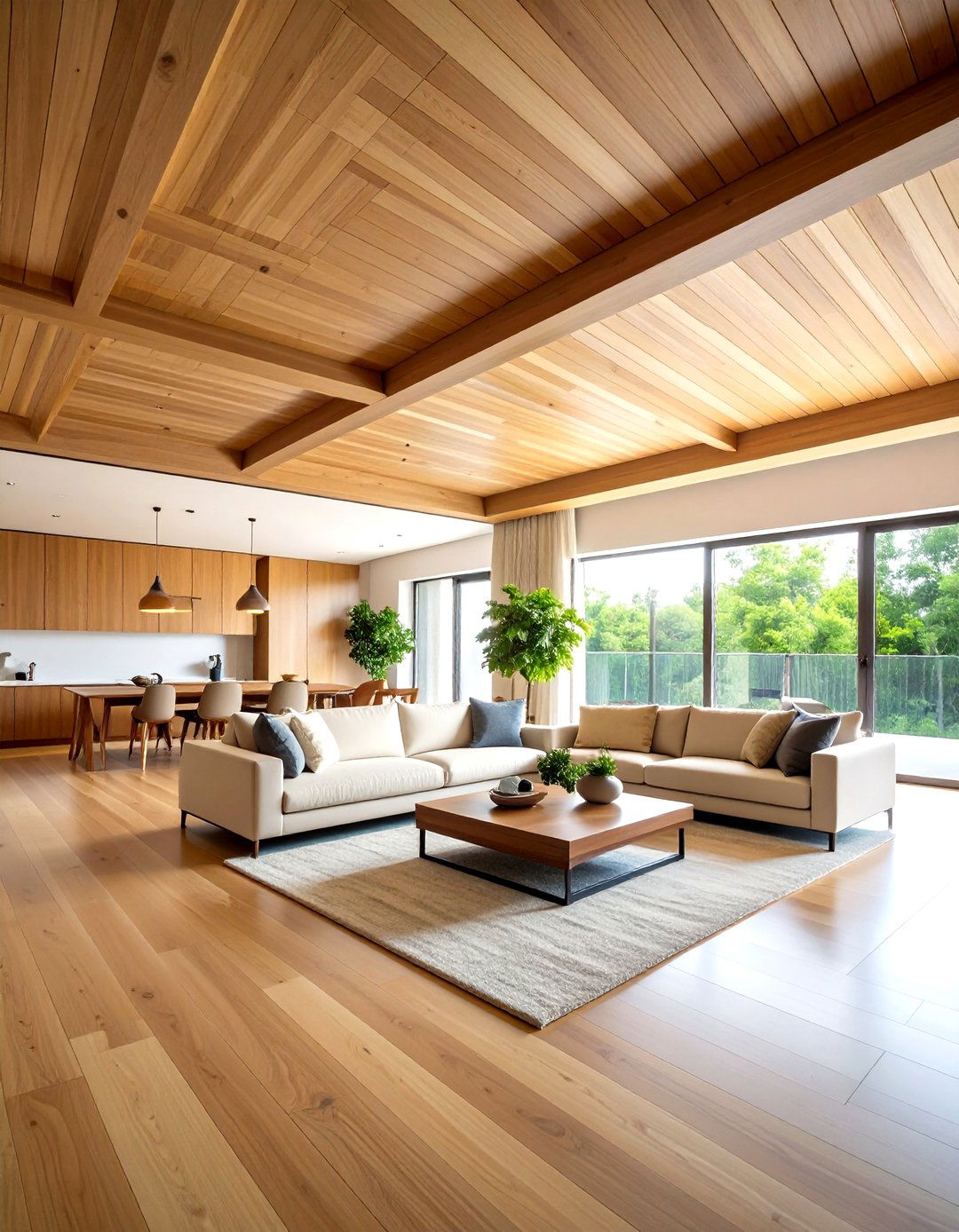
A minimalist approach to plywood ceiling design embraces clean lines and uncluttered spaces that exude contemporary elegance. This style utilizes smooth, uniform plywood panels arranged in simple geometric patterns to create a serene backdrop that enhances natural light and room proportions. The beauty lies in the material's natural wood grain, which adds organic warmth without overwhelming the space. Installation involves carefully aligned panels with minimal visible seams, often stained in light, neutral tones like natural oak or soft birch. This plywood ceiling design works exceptionally well in modern homes, open-concept spaces, and minimalist interiors where the focus remains on functionality and understated sophistication.
2. Herringbone Plywood Ceiling Pattern
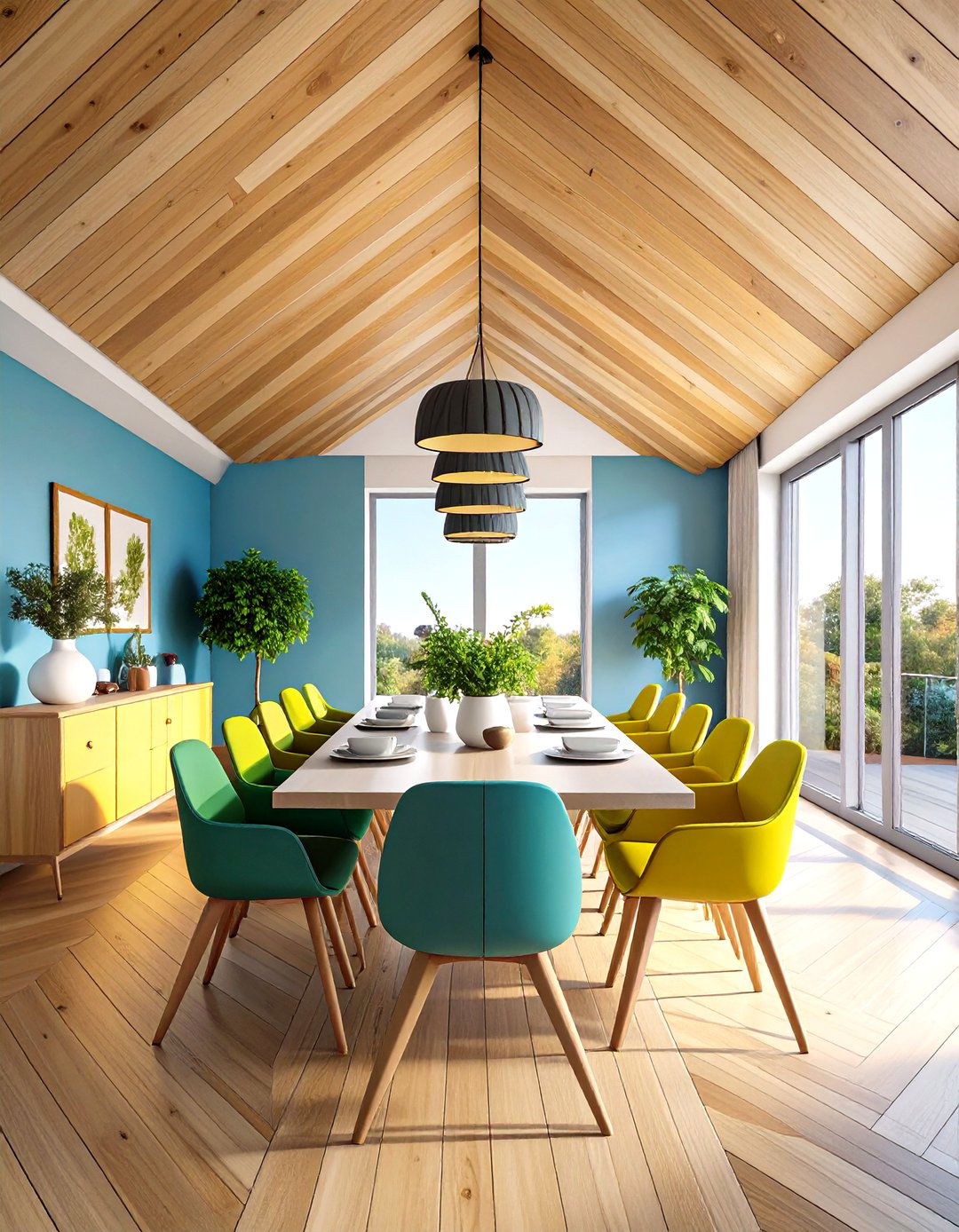
The herringbone plywood ceiling pattern creates a striking visual impact through its distinctive zigzag arrangement of wooden planks. This classic design involves cutting plywood into uniform strips and installing them at alternating 45-degree angles, forming a sophisticated geometric pattern that draws the eye upward. The alternating grain direction creates dynamic shadows and highlights that change throughout the day, adding depth and movement to the ceiling. This pattern works beautifully in dining rooms, living spaces, and bedrooms, complementing both traditional and contemporary decor styles. The herringbone plywood ceiling design requires precise measuring and cutting but delivers a luxurious appearance that rivals expensive hardwood installations while maintaining budget-friendly materials.
3. Coffered Plywood Ceiling Design
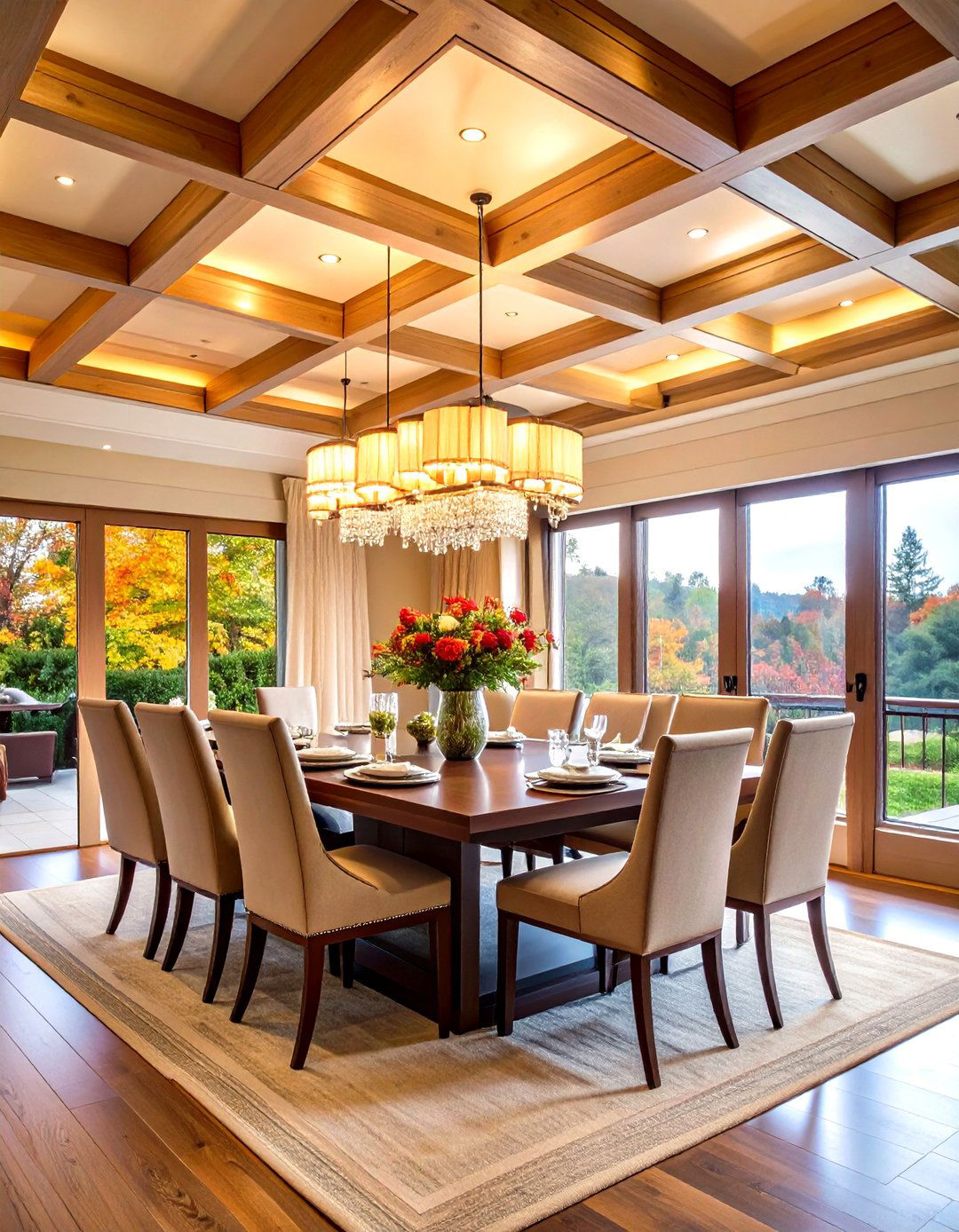
A coffered plywood ceiling design combines traditional architectural elegance with modern material efficiency. This style features a grid of recessed panels created by installing plywood beams in a rectangular or square pattern, forming decorative sunken sections that add dimensional interest to the ceiling. The coffered approach works particularly well in formal dining rooms, libraries, and home offices where a sense of grandeur is desired. Each recessed panel can be painted or stained differently to create contrast, while integrated LED lighting can be installed within the coffers for dramatic illumination. This plywood ceiling design technique transforms flat surfaces into architectural focal points that enhance the room's perceived height and sophistication.
4. Geometric Plywood Ceiling Patterns
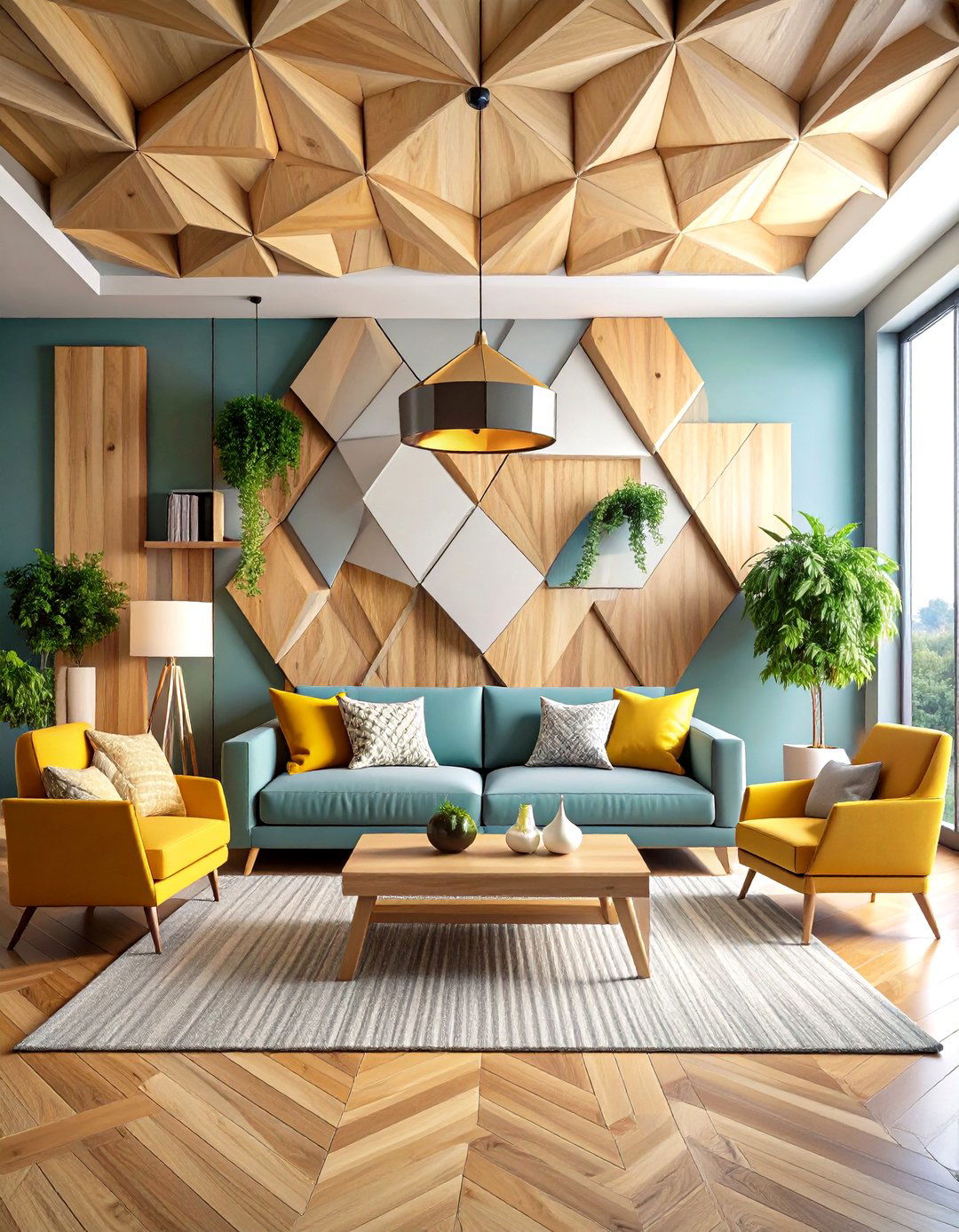
Geometric plywood ceiling patterns offer endless creative possibilities through the strategic arrangement of panels in triangular, hexagonal, or diamond configurations. This modern approach involves cutting plywood into specific shapes and assembling them into complex patterns that create stunning visual effects. The geometric design can incorporate varying plywood thicknesses to achieve three-dimensional textures, while different stain colors can highlight individual shapes within the overall pattern. This style works exceptionally well in contemporary homes, creative spaces, and areas where artistic expression is valued. The geometric plywood ceiling design serves as both functional covering and sculptural art piece, transforming ordinary rooms into extraordinary environments.
5. Rustic Barnwood Plywood Ceiling Style
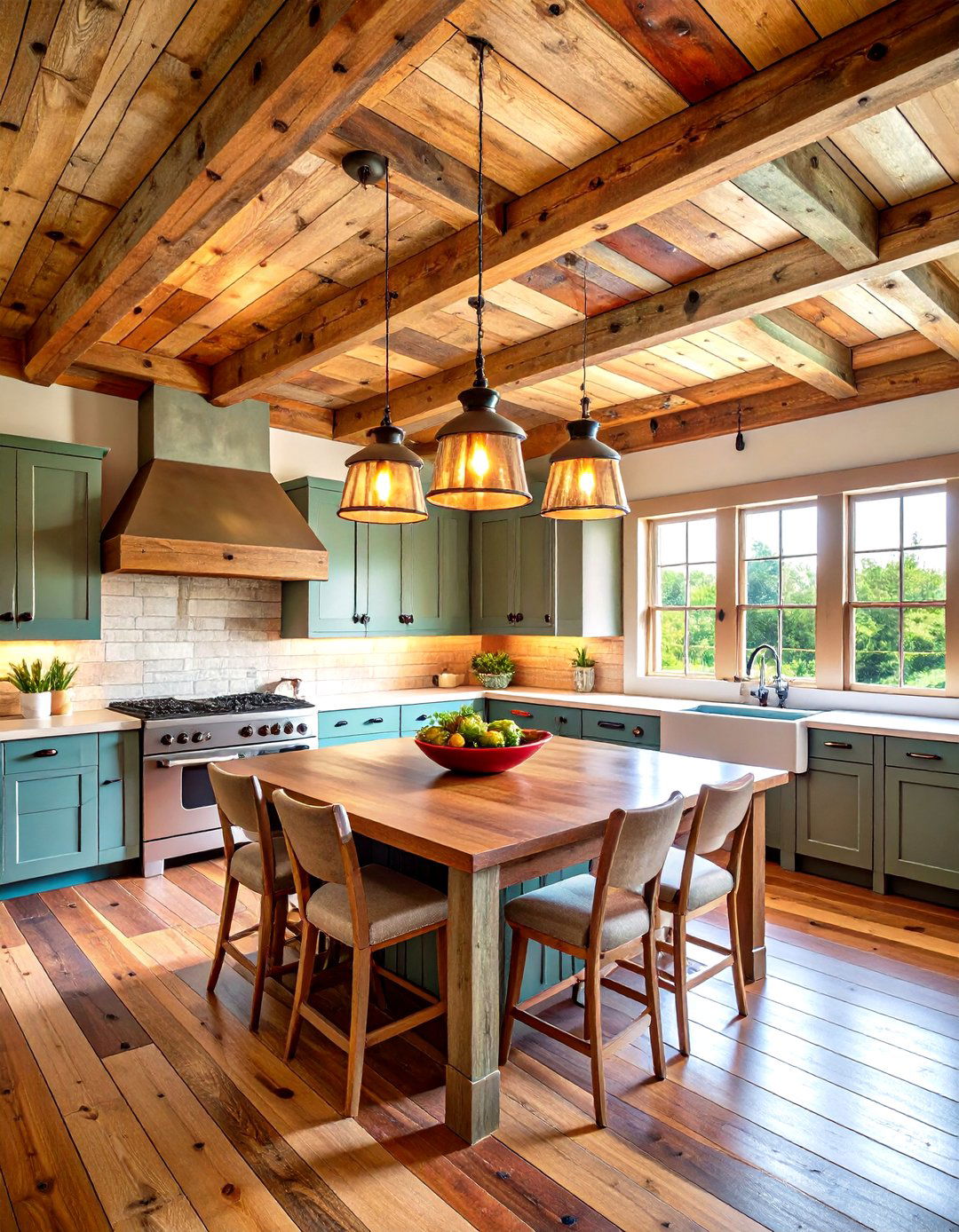
A rustic barnwood plywood ceiling style captures the authentic charm of reclaimed materials while utilizing affordable plywood as the base material. This approach involves applying weathered finishes, distressing techniques, and various stain colors to create the appearance of aged, weathered wood. The rustic plywood ceiling design incorporates irregular plank widths, visible knots, and intentional imperfections that add character and warmth to the space. This style works beautifully in farmhouse kitchens, country living rooms, and cabins where cozy, lived-in aesthetics are desired. The rustic finish can be achieved through specialized staining techniques, sandblasting, or chemical treatments that create authentic aging effects without the expense of genuine reclaimed lumber.
6. Modern Industrial Plywood Ceiling Design
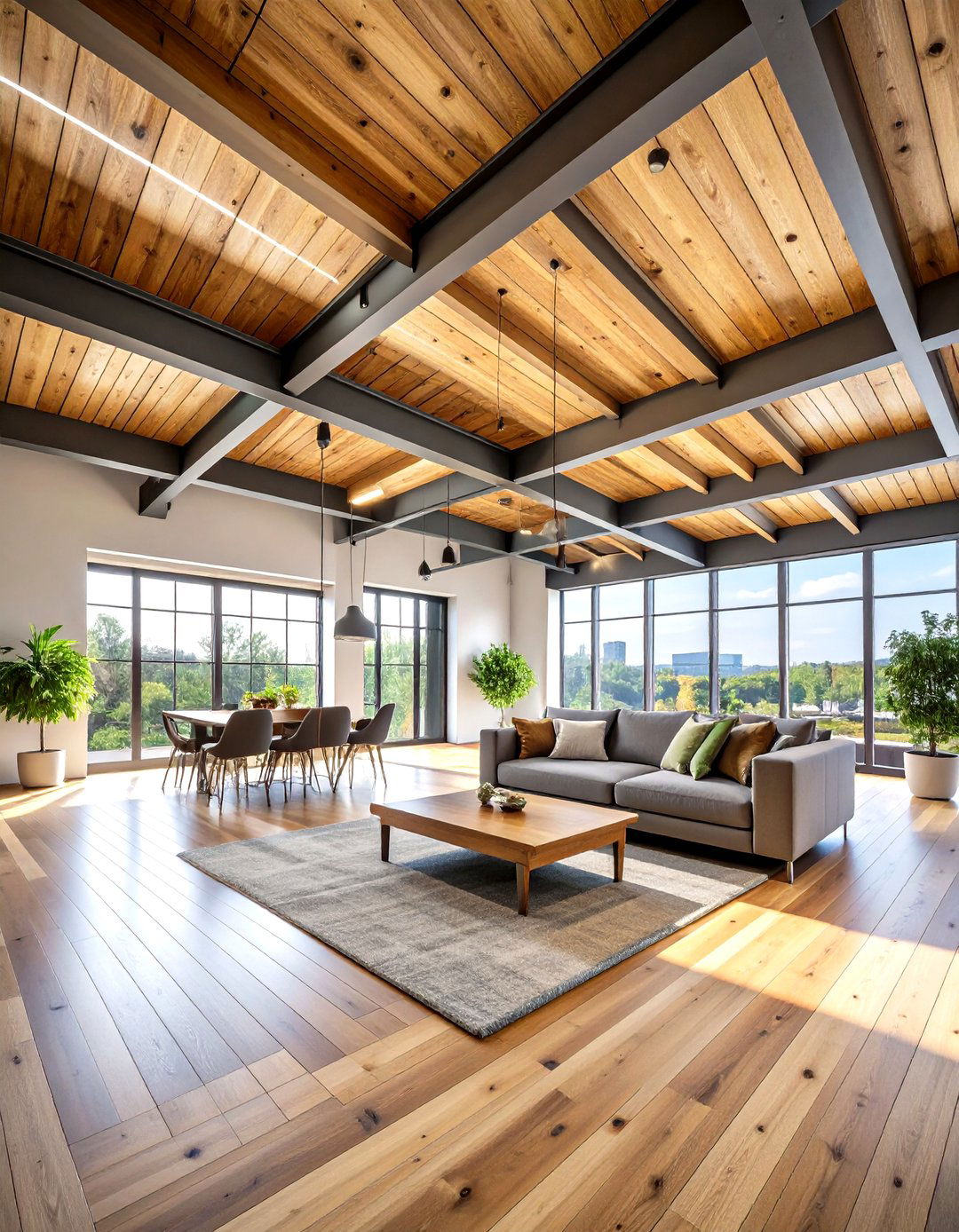
The modern industrial plywood ceiling design blends utilitarian aesthetics with contemporary sophistication, creating a unique urban atmosphere. This style features raw plywood textures combined with metal accents, exposed hardware, and bold geometric patterns that celebrate the material's industrial origins. The design often incorporates visible fasteners, steel beam details, and minimalist color schemes dominated by natural wood tones, grays, and blacks. This plywood ceiling approach works exceptionally well in loft apartments, modern offices, and urban homes where edgy, contemporary aesthetics are preferred. The industrial style can be enhanced with exposed electrical conduits, pendant lighting, and metal trim pieces that reinforce the utilitarian theme while maintaining sophisticated design sensibilities.
7. Acoustic Plywood Ceiling Panels
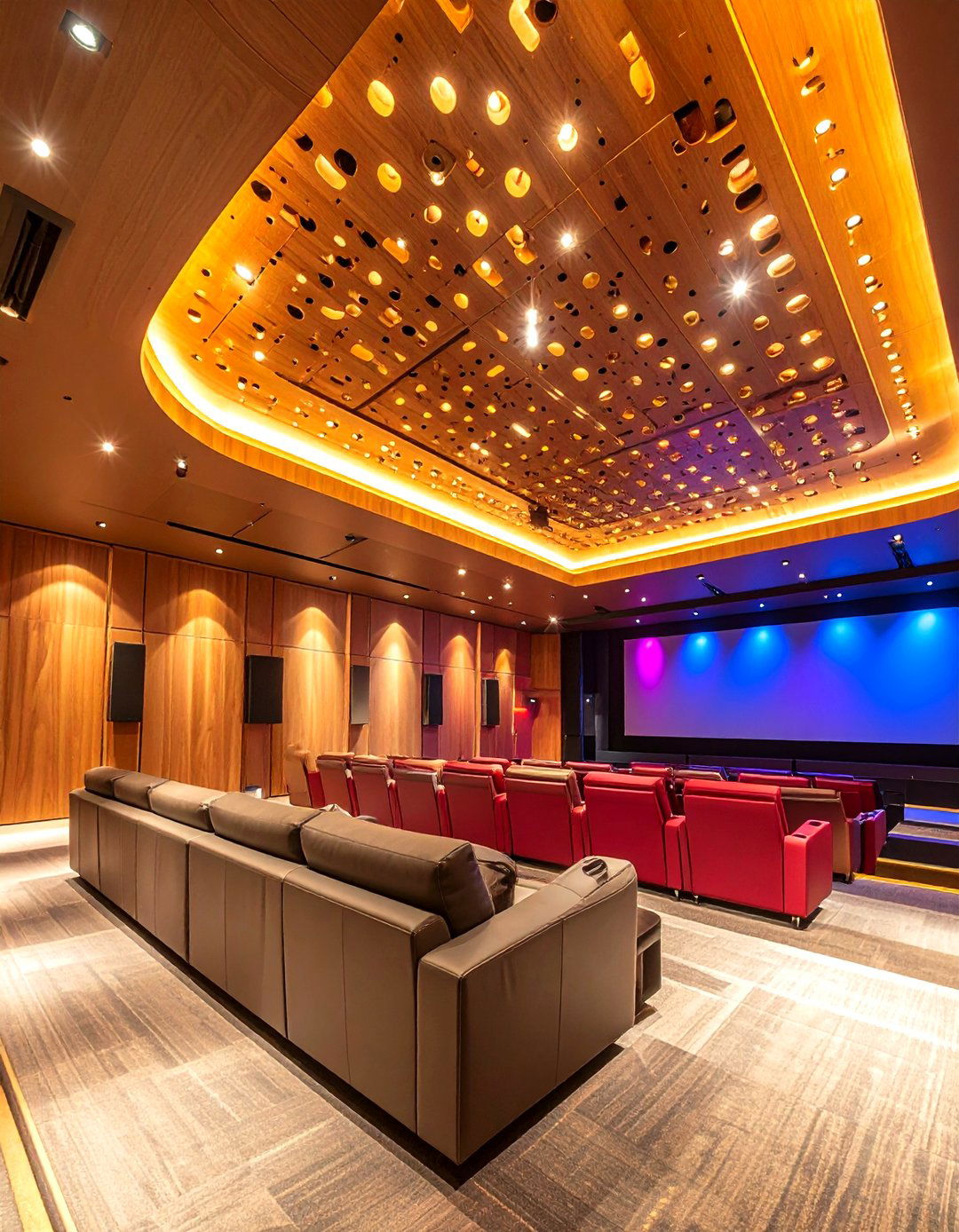
Acoustic plywood ceiling panels combine sound control functionality with aesthetic appeal, creating environments that are both visually striking and acoustically optimized. This design incorporates perforated plywood panels or slotted configurations that allow sound waves to penetrate into sound-absorbing materials hidden behind the ceiling surface. The acoustic plywood ceiling design works particularly well in home theaters, music rooms, and open-concept spaces where noise control is essential. The panels can be arranged in various patterns while maintaining their sound-dampening properties, and the natural wood appearance provides warmth that traditional acoustic tiles cannot match. This approach offers superior sound absorption while creating a sophisticated, residential-quality finish.
8. Suspended Plywood Ceiling System
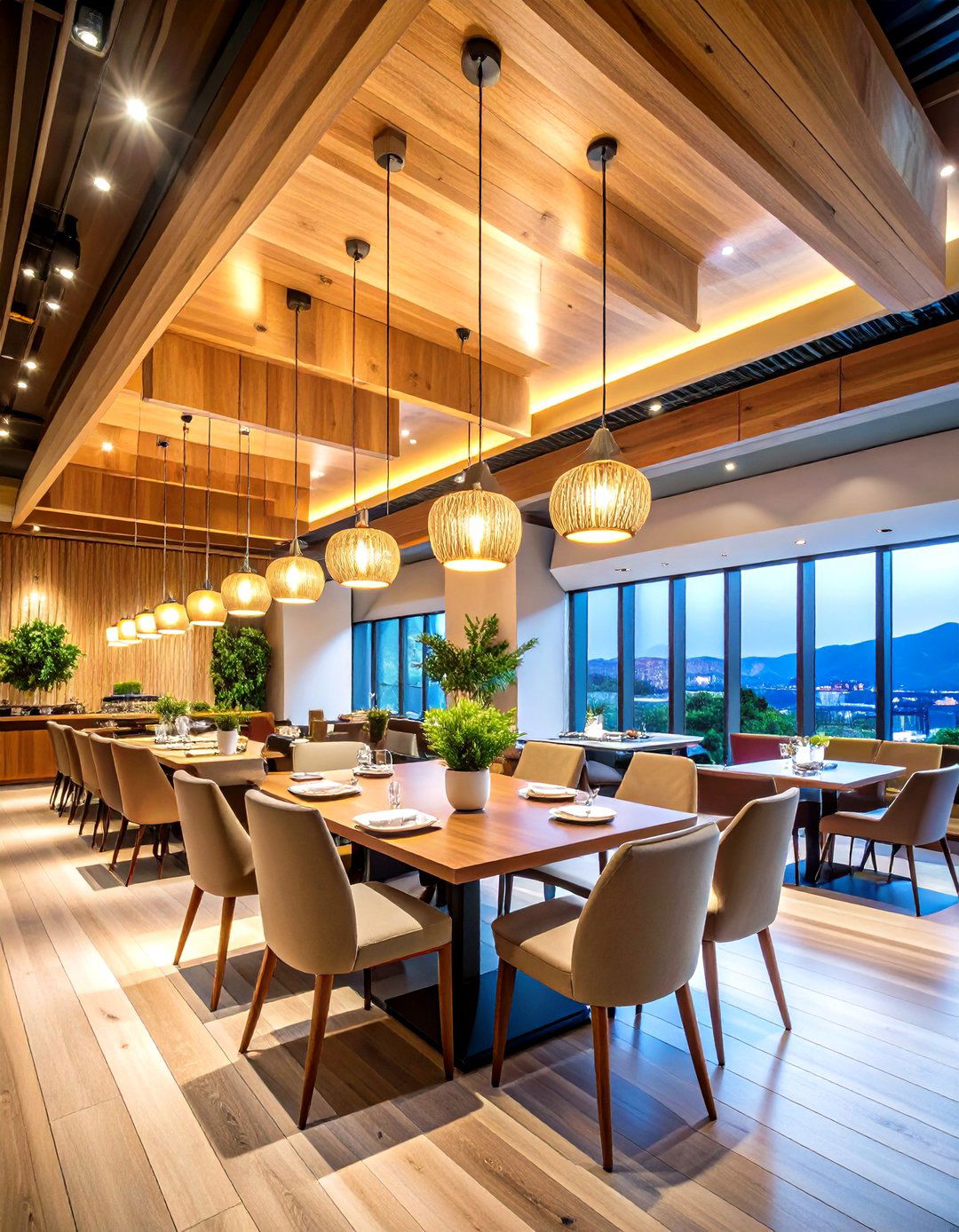
A suspended plywood ceiling system creates dramatic spatial effects through the strategic placement of hanging panels that appear to float above the room. This innovative design involves mounting plywood panels at various heights using cables, chains, or hidden brackets, creating layers of visual interest and architectural depth. The suspended plywood ceiling design works beautifully in modern homes, restaurants, and commercial spaces where dynamic ceiling treatments are desired. The panels can be arranged in geometric patterns, organic shapes, or linear configurations that complement the room's overall design theme. This approach allows for creative lighting integration, with LED strips or spotlights highlighting the suspended elements while maintaining easy access to utilities above.
9. Grid Pattern Plywood Ceiling Design
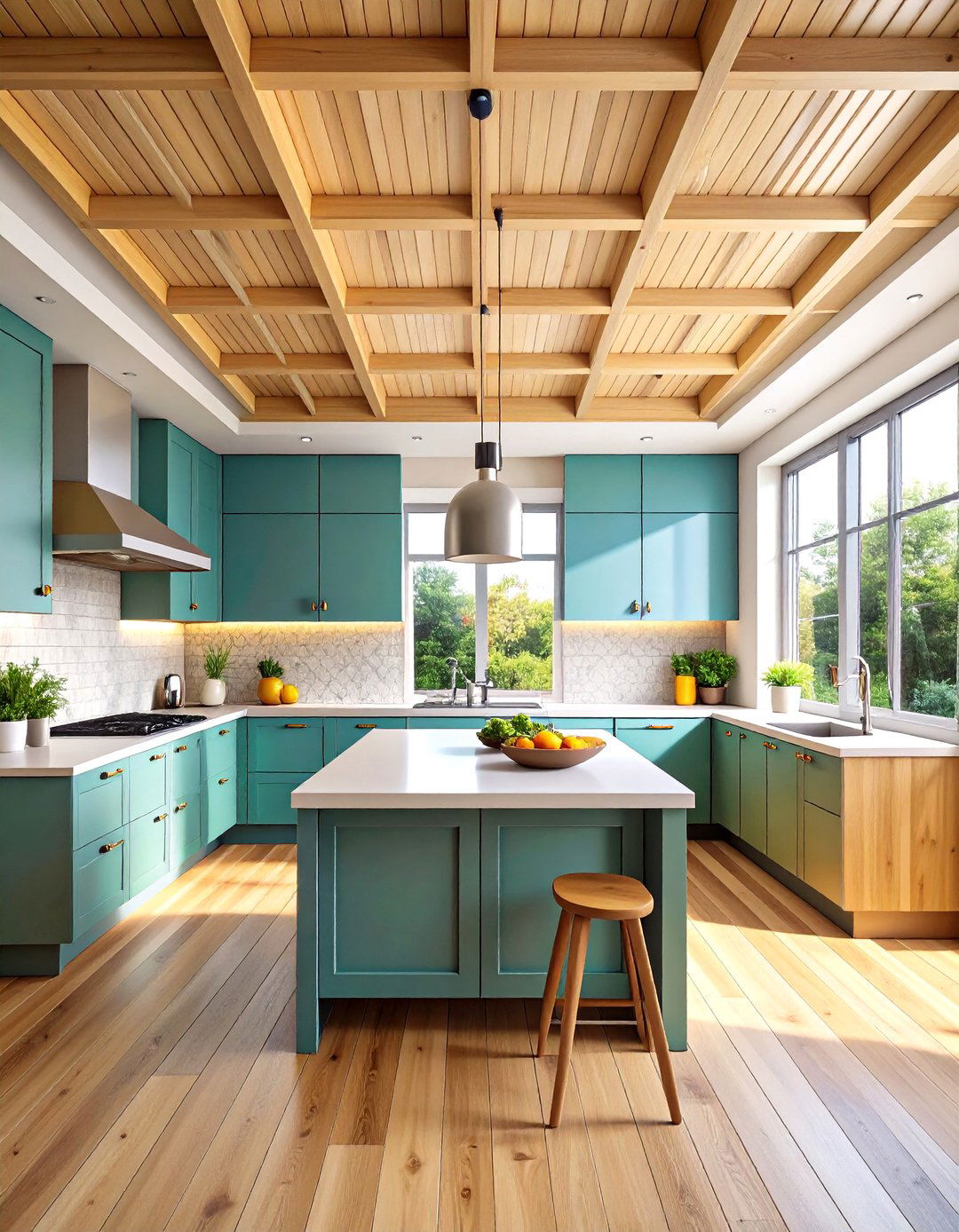
The grid pattern plywood ceiling design creates organized, structured aesthetics through the systematic arrangement of plywood panels in rectangular or square configurations. This approach involves installing plywood strips as dividers between panel sections, creating a clean, geometric appearance that adds order and sophistication to the space. The grid plywood ceiling design works particularly well in modern kitchens, offices, and minimalist interiors where clean lines are valued. Each grid section can be treated differently through staining, painting, or texturing to create visual variety within the overall pattern. This systematic approach provides excellent opportunities for integrated lighting, ventilation, and access panels while maintaining a cohesive, professional appearance.
10. Chevron Plywood Ceiling Pattern
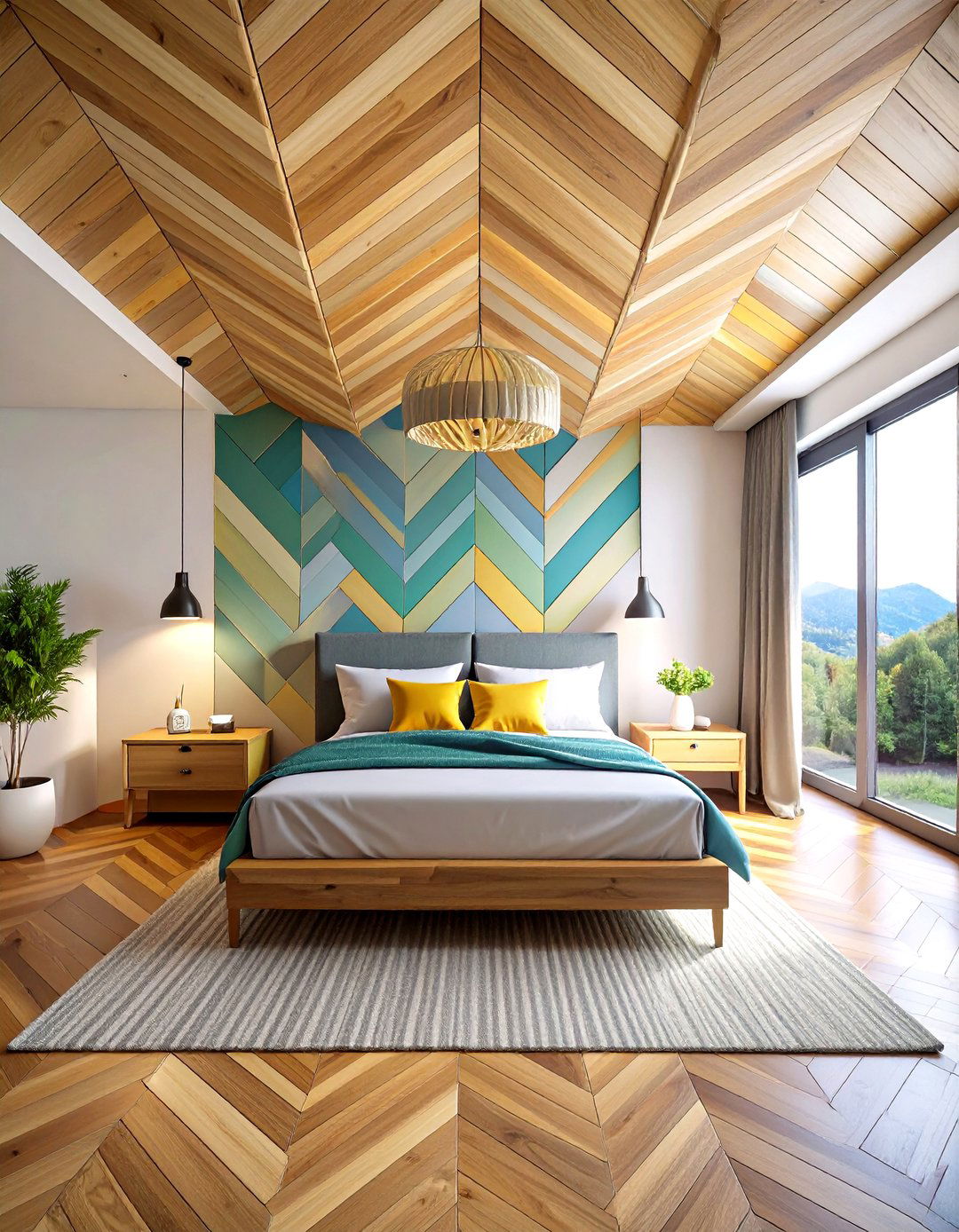
The chevron plywood ceiling pattern creates dynamic visual movement through the strategic arrangement of plywood planks in V-shaped configurations. This design involves cutting plywood into uniform strips and installing them at specific angles to create continuous zigzag patterns that draw the eye across the ceiling surface. The chevron pattern adds energy and sophistication to any room while maintaining the warmth and natural beauty of wood materials. This plywood ceiling design works exceptionally well in contemporary dining rooms, bedrooms, and living spaces where geometric interest is desired. The chevron configuration can be enhanced with contrasting stain colors, integrated lighting, or varying plank widths to create personalized design expressions.
11. Plywood Tray Ceiling Design
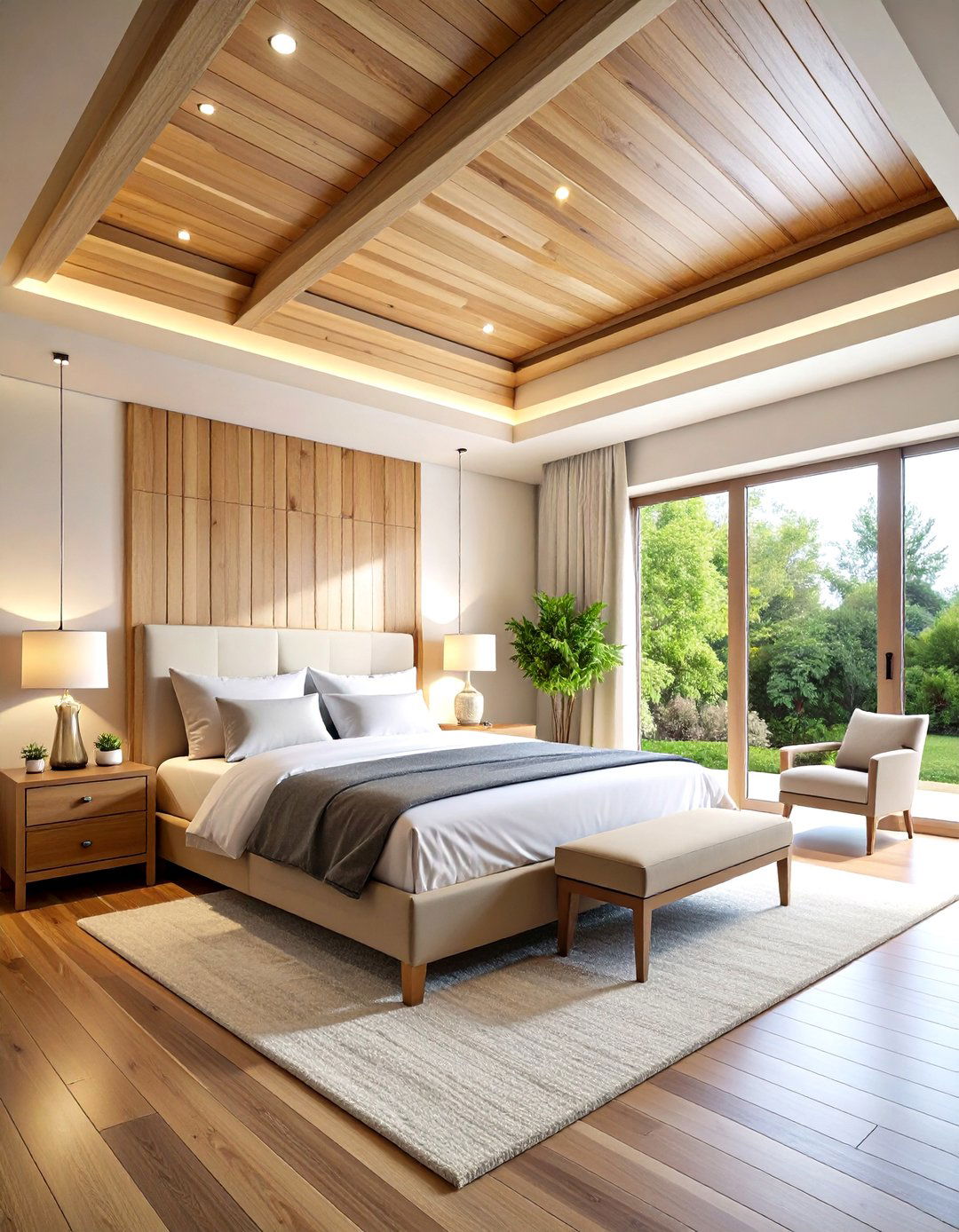
A plywood tray ceiling design elevates room aesthetics through the creation of recessed central sections that add architectural depth and visual interest. This approach involves building a stepped ceiling configuration using plywood panels at different levels, creating the illusion of a tray or recessed area in the ceiling center. The tray plywood ceiling design works beautifully in bedrooms, dining rooms, and formal living spaces where elegant architectural details are desired. The recessed area can accommodate special lighting treatments, decorative painting, or different wood finishes that contrast with the surrounding ceiling area. This design technique effectively increases the perceived room height while creating sophisticated focal points that enhance the overall interior design.
12. Textured Plywood Ceiling Finish

Textured plywood ceiling finishes create tactile and visual interest through the application of various surface treatments that enhance the natural wood characteristics. This approach involves using techniques like wire brushing, sanding, routing, or chemical treatments to create unique surface textures that add depth and character to the ceiling. The textured plywood ceiling design works particularly well in rustic, craftsman, and transitional interior styles where natural materials are celebrated. The texture can be enhanced with strategic lighting that creates shadows and highlights, emphasizing the three-dimensional surface qualities. This finish approach transforms ordinary plywood into sophisticated architectural elements that provide both visual appeal and tactile interest.
13. Painted Plywood Ceiling Design
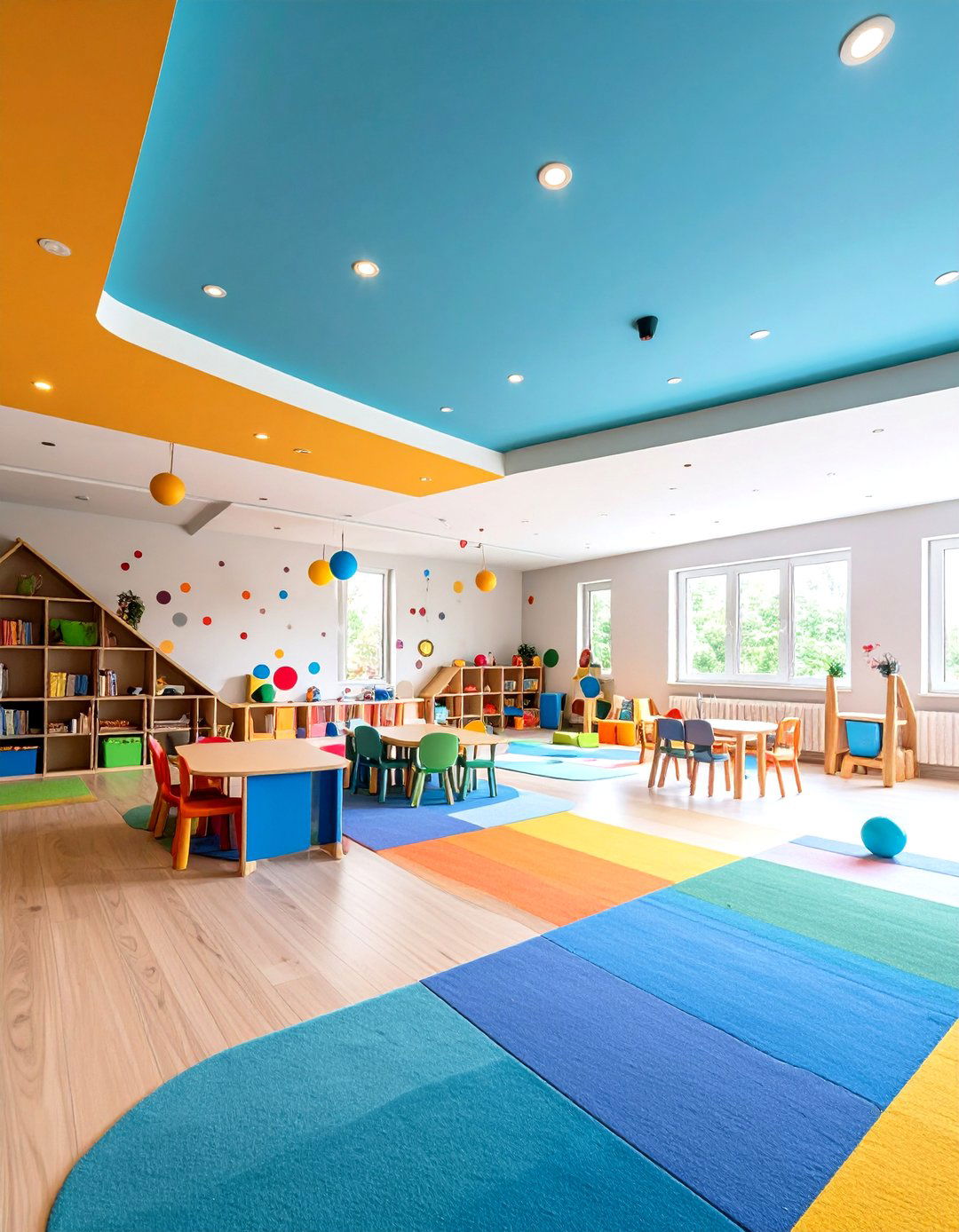
Painted plywood ceiling designs offer unlimited color possibilities while maintaining the structural benefits and cost-effectiveness of plywood materials. This approach involves applying primer and paint to create smooth, uniform surfaces that can match any interior color scheme or design theme. The painted plywood ceiling design works exceptionally well in contemporary homes, children's rooms, and spaces where specific color coordination is required. The paint can be applied in solid colors, gradient effects, or decorative patterns that complement the room's overall design. This approach allows for easy updates and modifications while providing a clean, finished appearance that rivals traditional drywall installations at a fraction of the cost.
14. Reclaimed-Style Plywood Ceiling
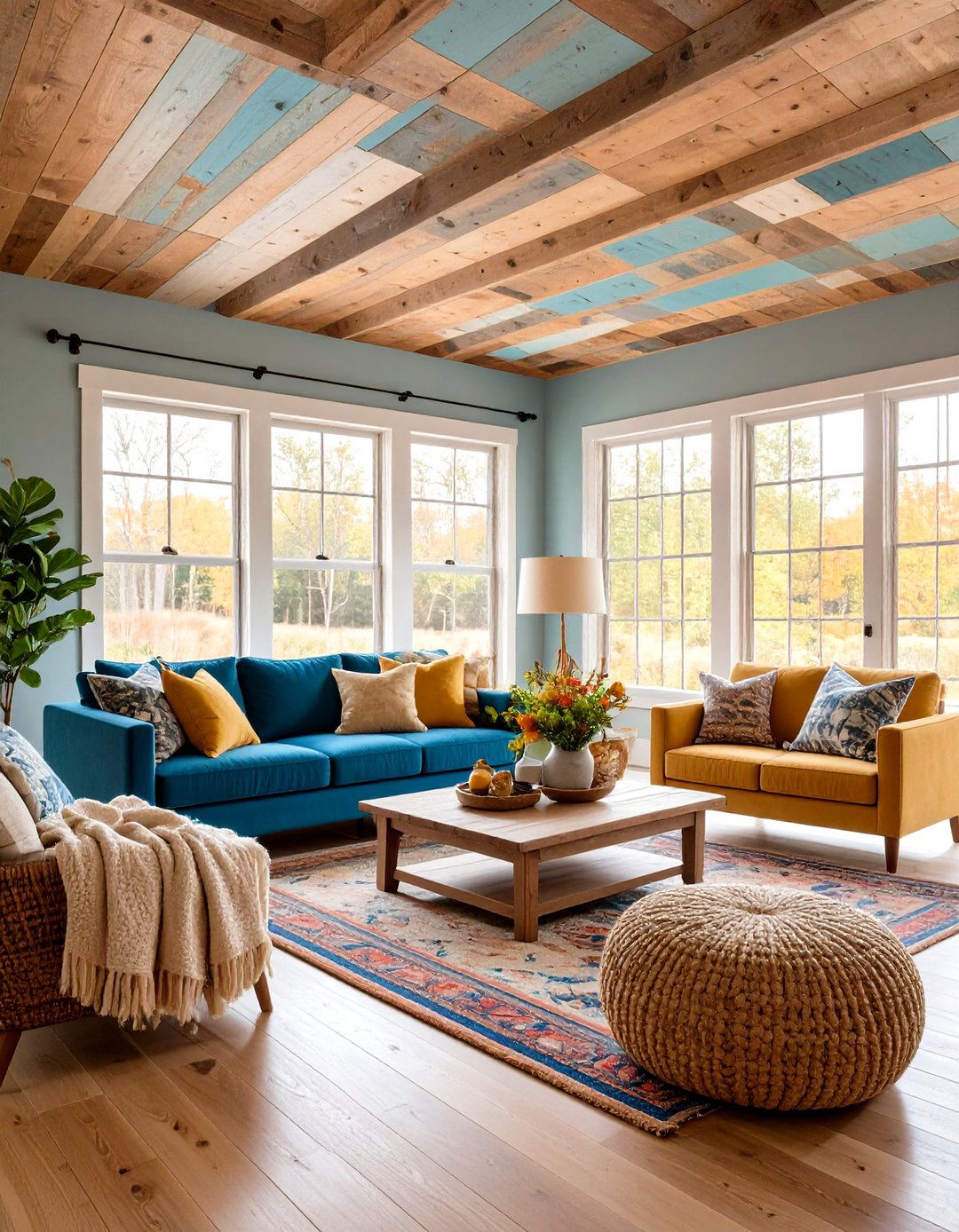
The reclaimed-style plywood ceiling captures the authentic character of salvaged materials while utilizing new plywood as the base material. This approach involves applying specialized finishing techniques that create the appearance of weathered, aged wood with natural patina, wear marks, and color variations. The reclaimed plywood ceiling design works beautifully in farmhouse kitchens, rustic living rooms, and spaces where sustainable, eco-friendly aesthetics are valued. The finish can incorporate multiple stain colors, distressing techniques, and protective coatings that create authentic aging effects. This style provides the charm and character of genuine reclaimed lumber while ensuring consistent quality, availability, and easier installation than authentic salvaged materials.
15. Layered Plywood Ceiling Design
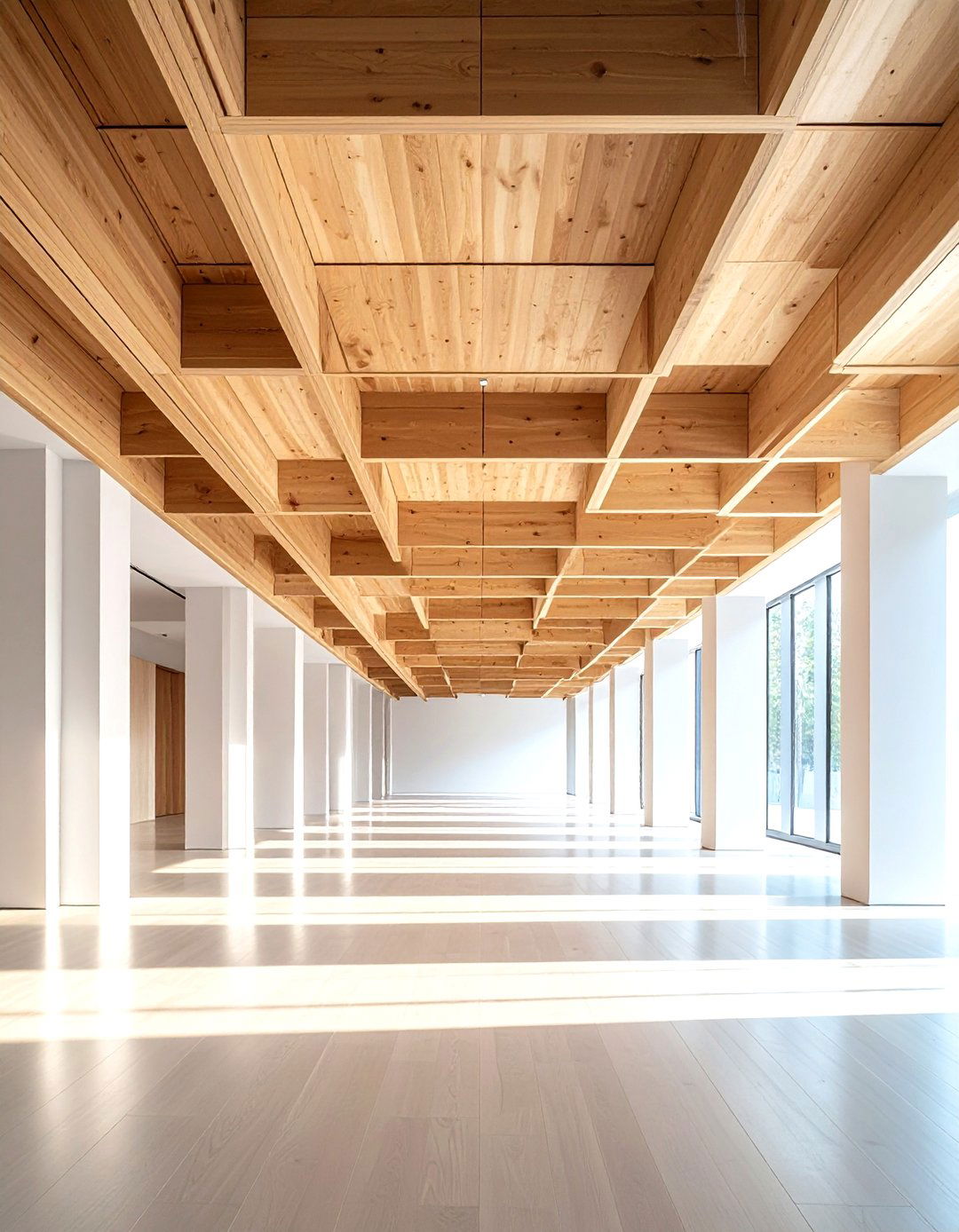
Layered plywood ceiling designs create stunning three-dimensional effects through the strategic stacking and arrangement of plywood panels at different depths and angles. This innovative approach involves installing multiple plywood layers to create architectural shadows, highlights, and geometric patterns that add dramatic visual interest to the ceiling. The layered plywood ceiling design works exceptionally well in modern homes, galleries, and spaces where artistic expression is valued. Each layer can be treated with different finishes, stains, or paint colors to enhance the dimensional effects. This technique allows for creative lighting integration, with LED strips or spotlights highlighting the layer transitions while creating dynamic illumination patterns throughout the room.
16. Plywood Plank Ceiling Design
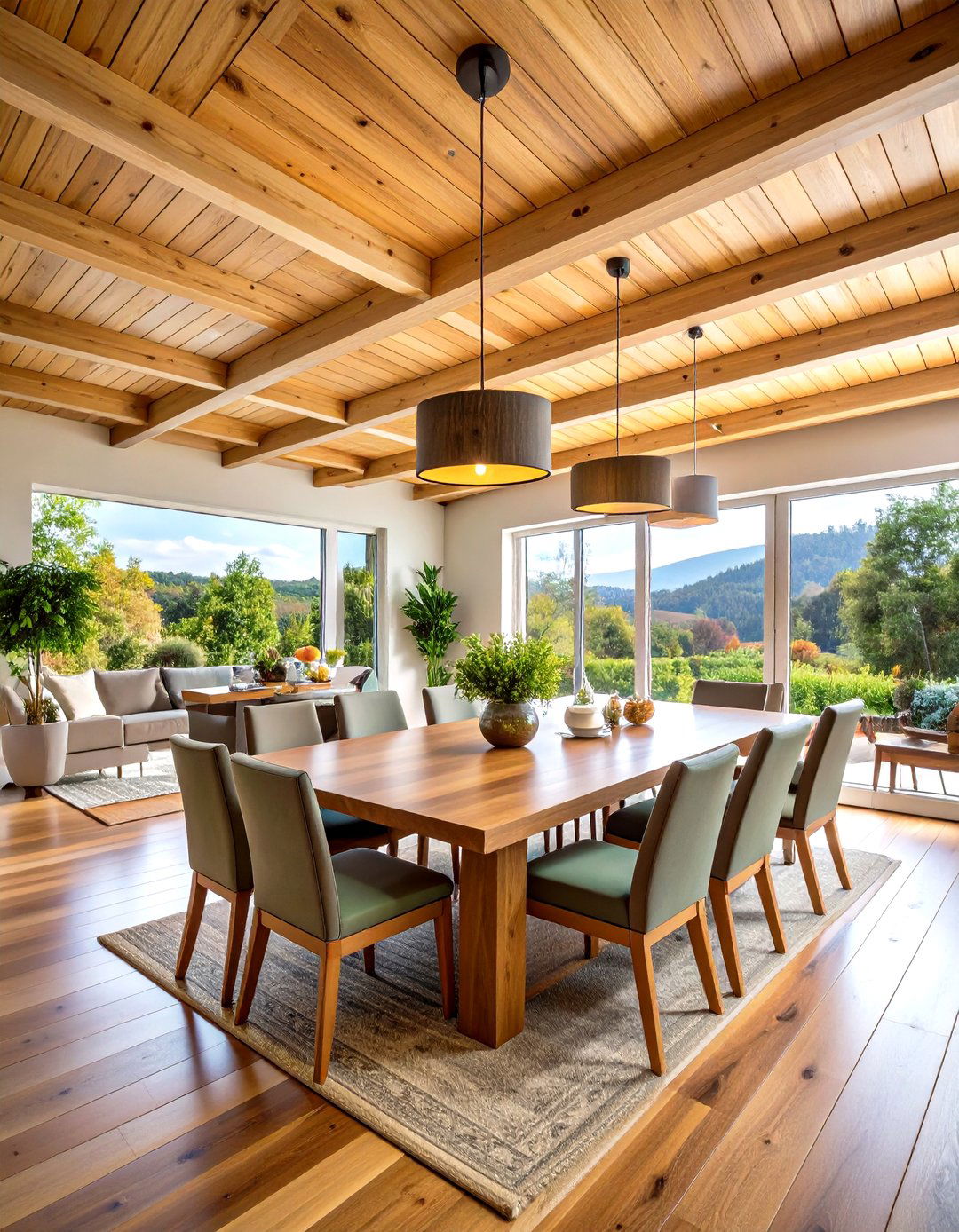
The plywood plank ceiling design recreates the classic appearance of individual wood planks using efficient plywood installation techniques. This approach involves cutting plywood into plank-width strips and installing them with visible seams that mimic traditional wood plank construction. The plywood plank ceiling design works beautifully in rustic, traditional, and transitional interior styles where wood warmth is desired. The planks can be installed in various orientations—horizontal, vertical, or diagonal—to create different visual effects and complement the room's proportions. This design approach provides the authentic appearance of solid wood planking while offering the structural stability, cost-effectiveness, and easier installation characteristics of plywood materials.
17. Whitewashed Plywood Ceiling Finish
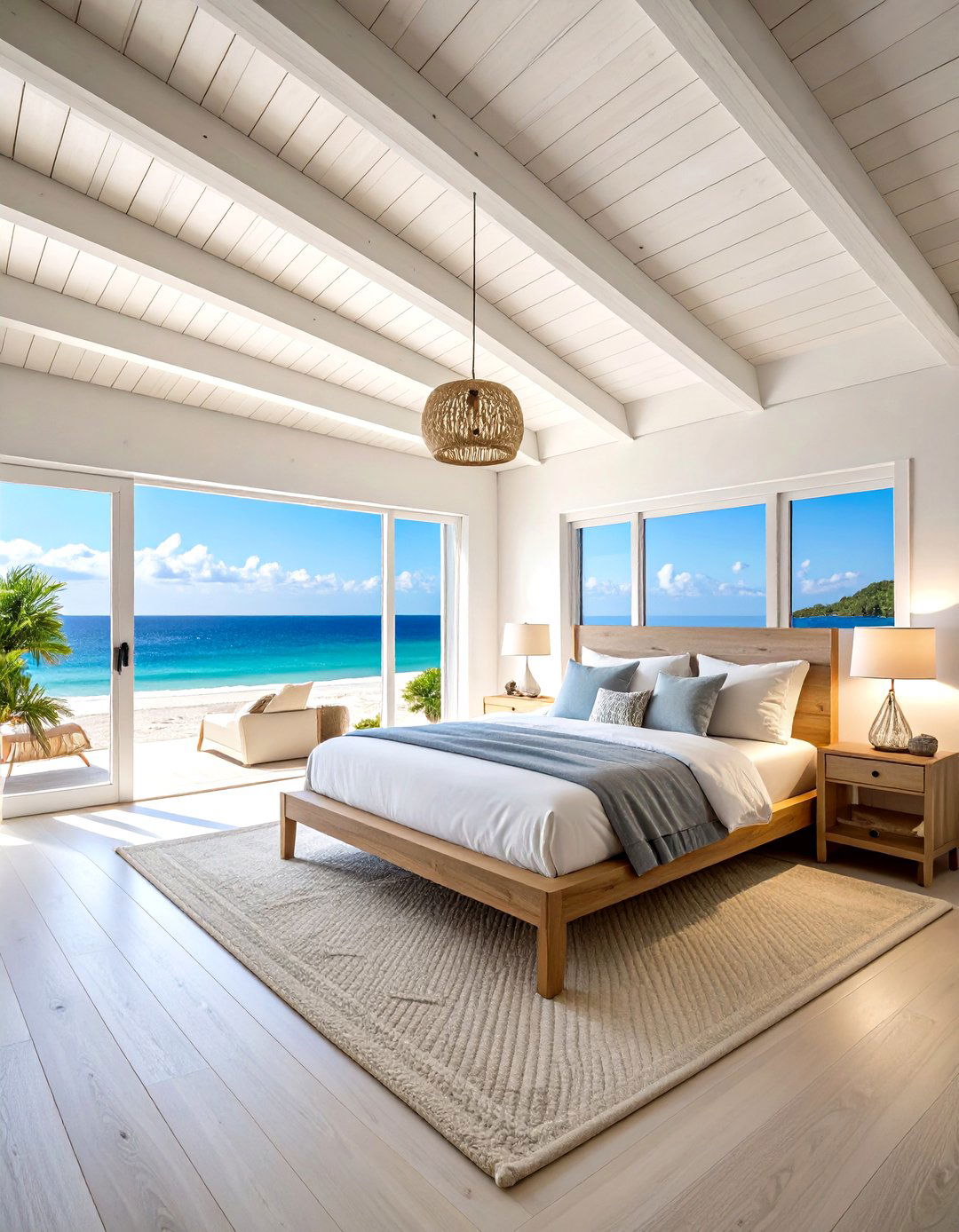
Whitewashed plywood ceiling finishes create bright, airy atmospheres while maintaining the natural wood grain characteristics that add warmth and texture to the space. This technique involves applying diluted white paint or specialized whitewash products that allow the wood grain to show through while lightening the overall appearance. The whitewashed plywood ceiling design works exceptionally well in coastal, farmhouse, and Scandinavian interior styles where light, natural aesthetics are preferred. The whitewash can be applied in varying intensities to create different opacity levels, from subtle tinting to more dramatic color transformation. This finish approach effectively brightens darker rooms while preserving the organic warmth and character that makes wood ceilings so appealing.
18. Mixed Material Plywood Ceiling Design
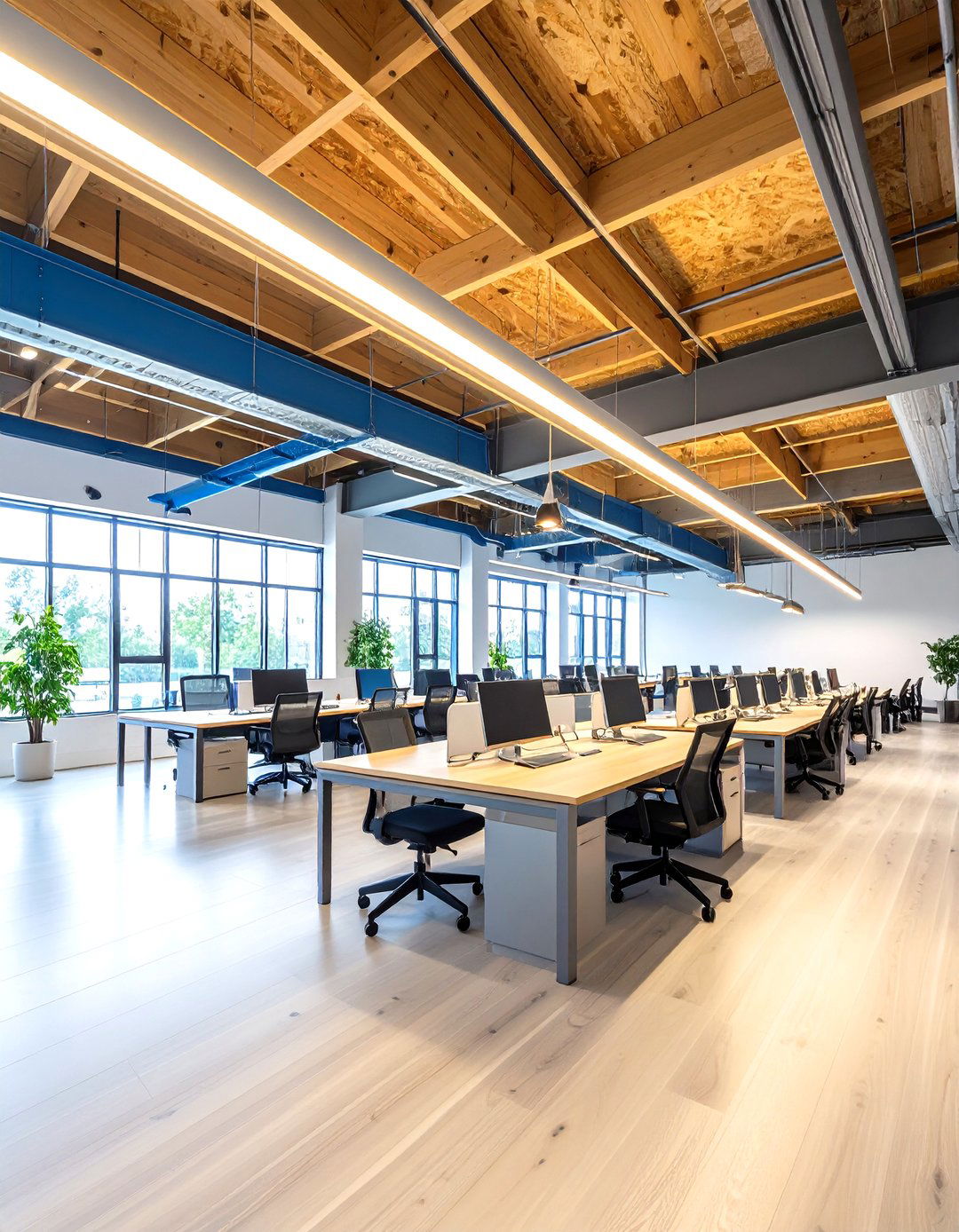
Mixed material plywood ceiling designs combine plywood with complementary materials like metal, glass, or fabric to create sophisticated, contemporary aesthetics. This approach involves integrating plywood panels with steel beams, decorative metal strips, or translucent panels that add visual variety and architectural interest. The mixed material plywood ceiling design works particularly well in modern homes, commercial spaces, and areas where innovative design solutions are valued. The combination of materials can create interesting contrasts in texture, color, and light reflection while maintaining the warmth and natural appeal of wood. This design approach allows for creative expression while providing practical benefits like improved acoustics, lighting integration, and utility access.
19. Artistic Plywood Ceiling Patterns

Artistic plywood ceiling patterns transform functional ceiling surfaces into creative expressions through the use of custom shapes, curves, and organic forms. This approach involves cutting plywood into unique configurations that create sculptural effects, flowing patterns, or abstract designs that serve as architectural art pieces. The artistic plywood ceiling design works exceptionally well in contemporary homes, galleries, and spaces where creative expression is valued over traditional architectural conventions. The patterns can incorporate varying plywood thicknesses, integrated lighting, and creative finishing techniques that enhance the artistic impact. This design approach allows for personalized expression while maintaining the practical benefits of plywood construction, creating unique environments that reflect individual style preferences.
20. Exposed Beam Plywood Ceiling Design

The exposed beam plywood ceiling design combines structural elements with decorative plywood panels to create authentic, craftsman-style aesthetics. This approach involves installing plywood panels between exposed or faux wooden beams, creating a traditional post-and-beam appearance that adds architectural character and warmth. The exposed beam plywood ceiling design works beautifully in rustic, traditional, and transitional interior styles where authentic construction details are valued. The beams can be actual structural elements or decorative additions that provide visual framework for the plywood panels. This design approach allows for creative lighting integration, with fixtures mounted on beams or recessed into plywood sections, while creating the solid, substantial appearance of traditional timber construction.
Conclusion:
Plywood ceiling designs offer remarkable versatility, combining affordability with aesthetic appeal to transform any interior space. From minimalist modern applications to rustic farmhouse styles, these twenty design approaches demonstrate the material's adaptability to various architectural themes and personal preferences. Whether you choose geometric patterns, textured finishes, or innovative suspension systems, plywood ceilings provide sustainable, cost-effective solutions that deliver both functional benefits and striking visual impact for today's design-conscious homeowners.


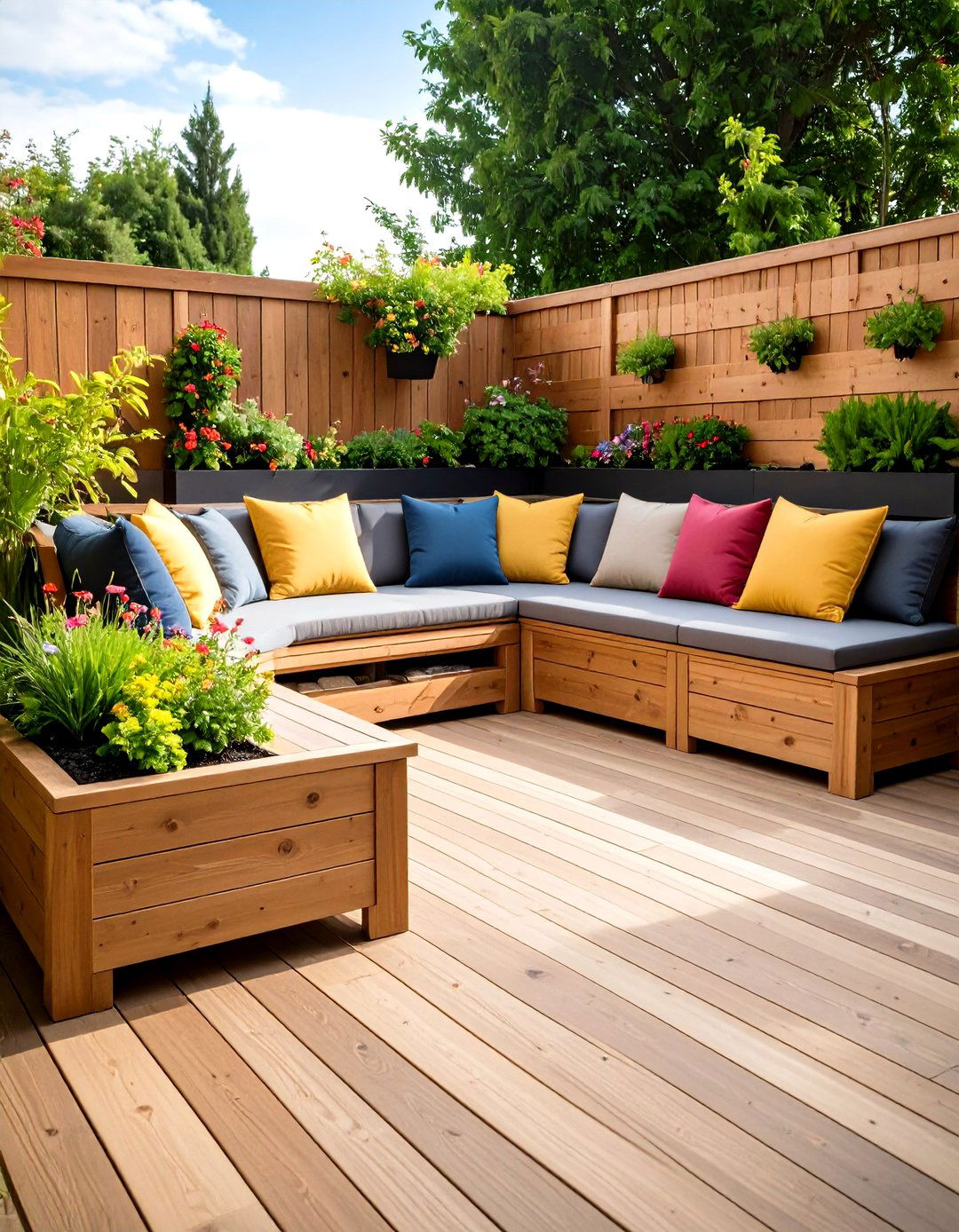
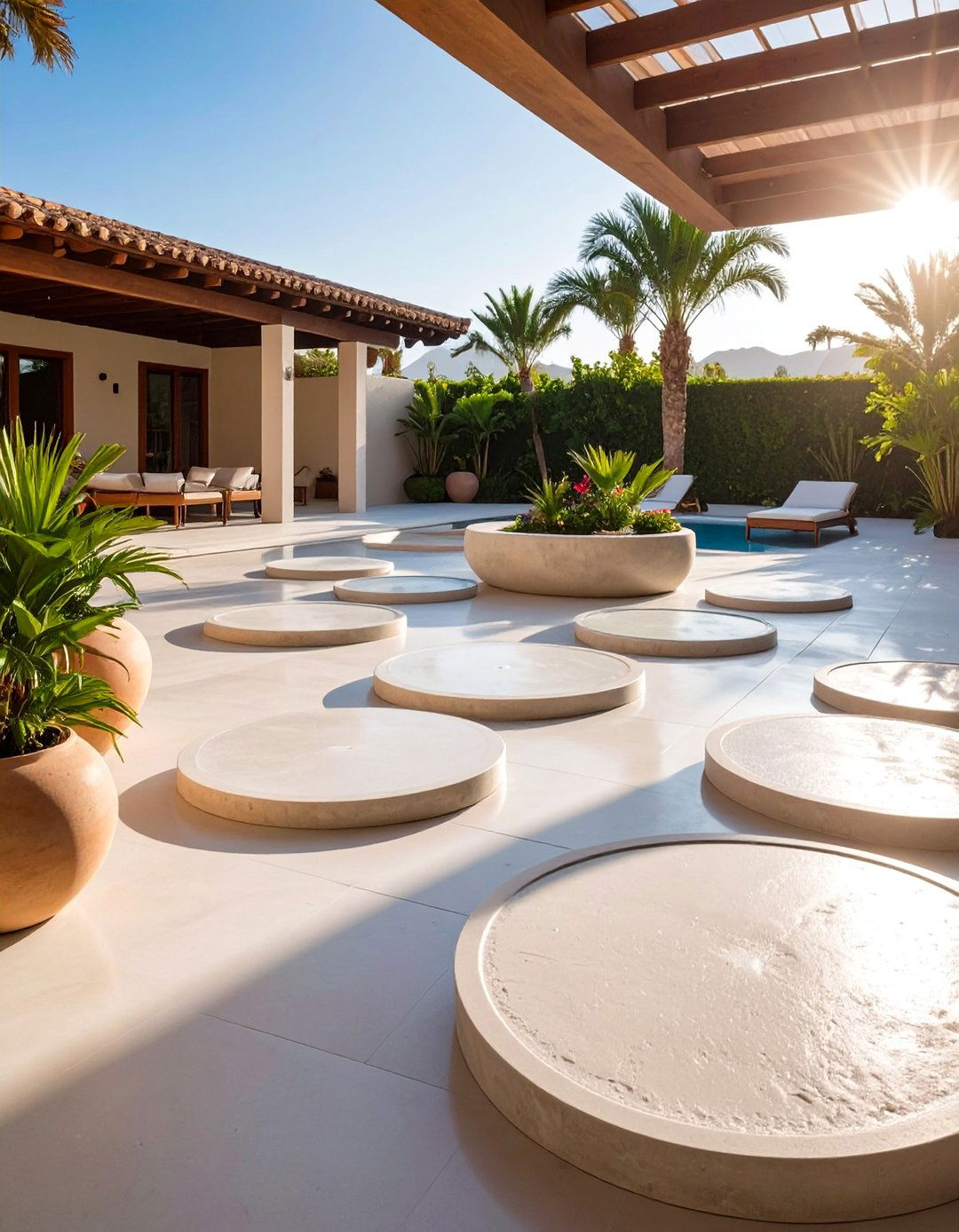
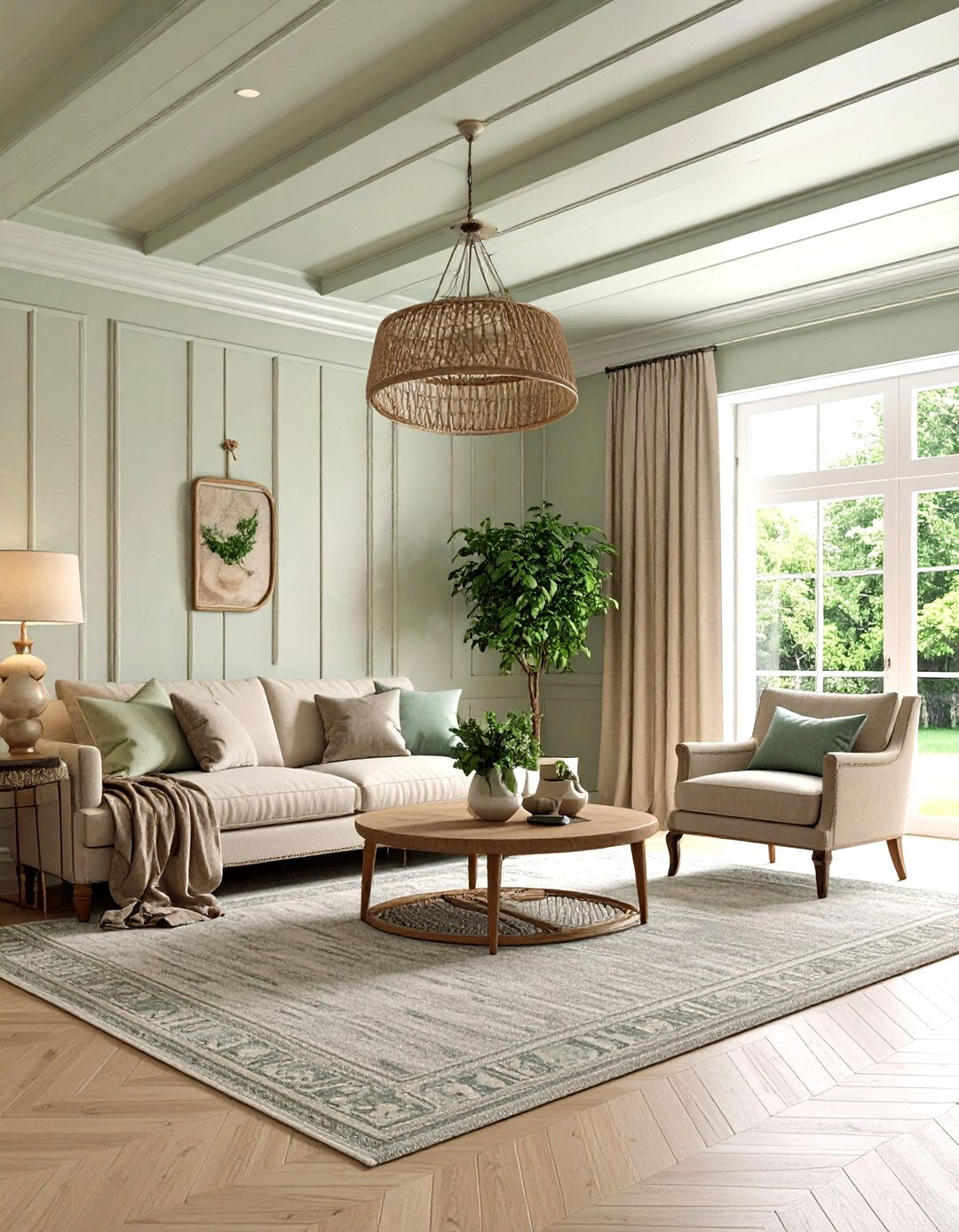
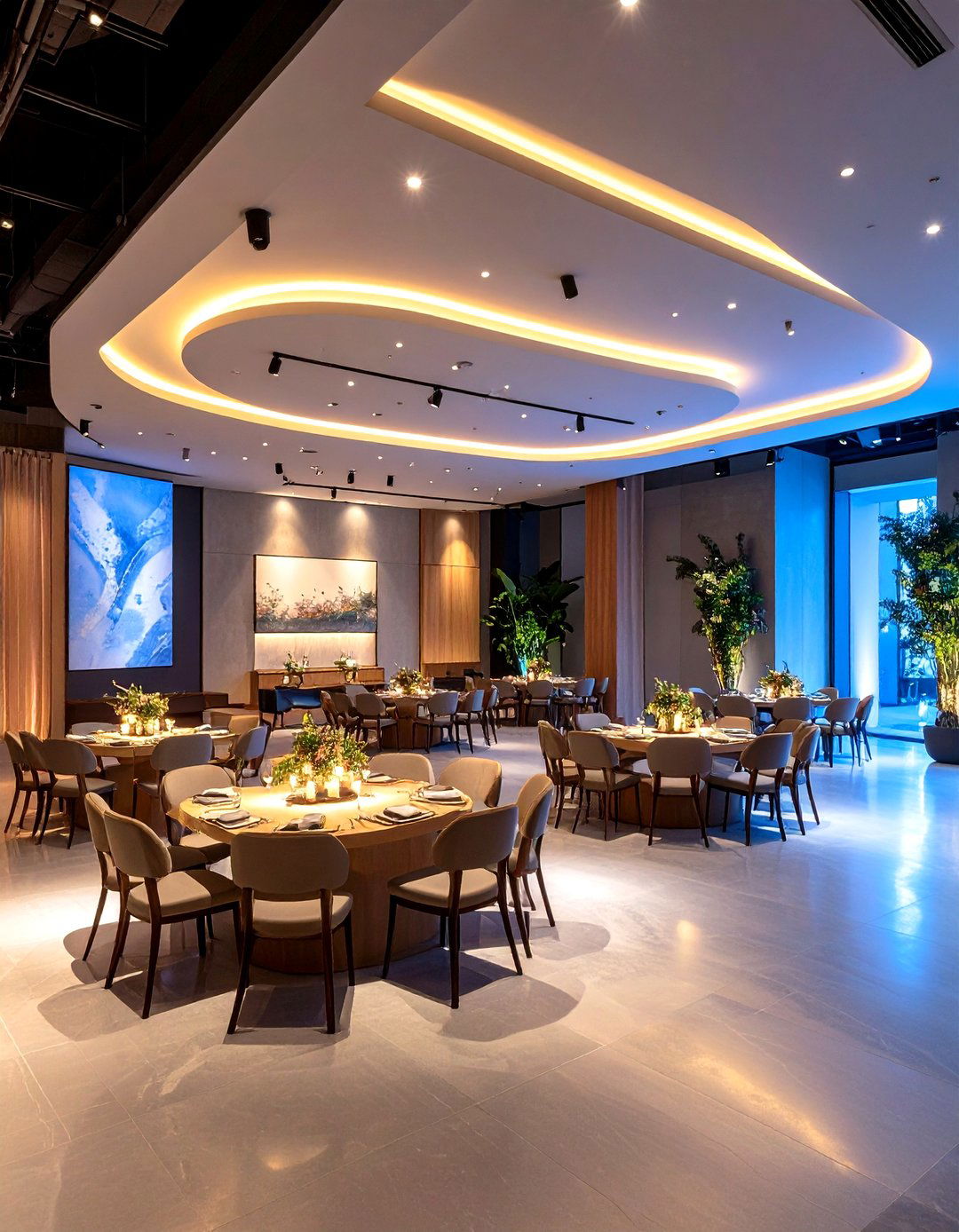
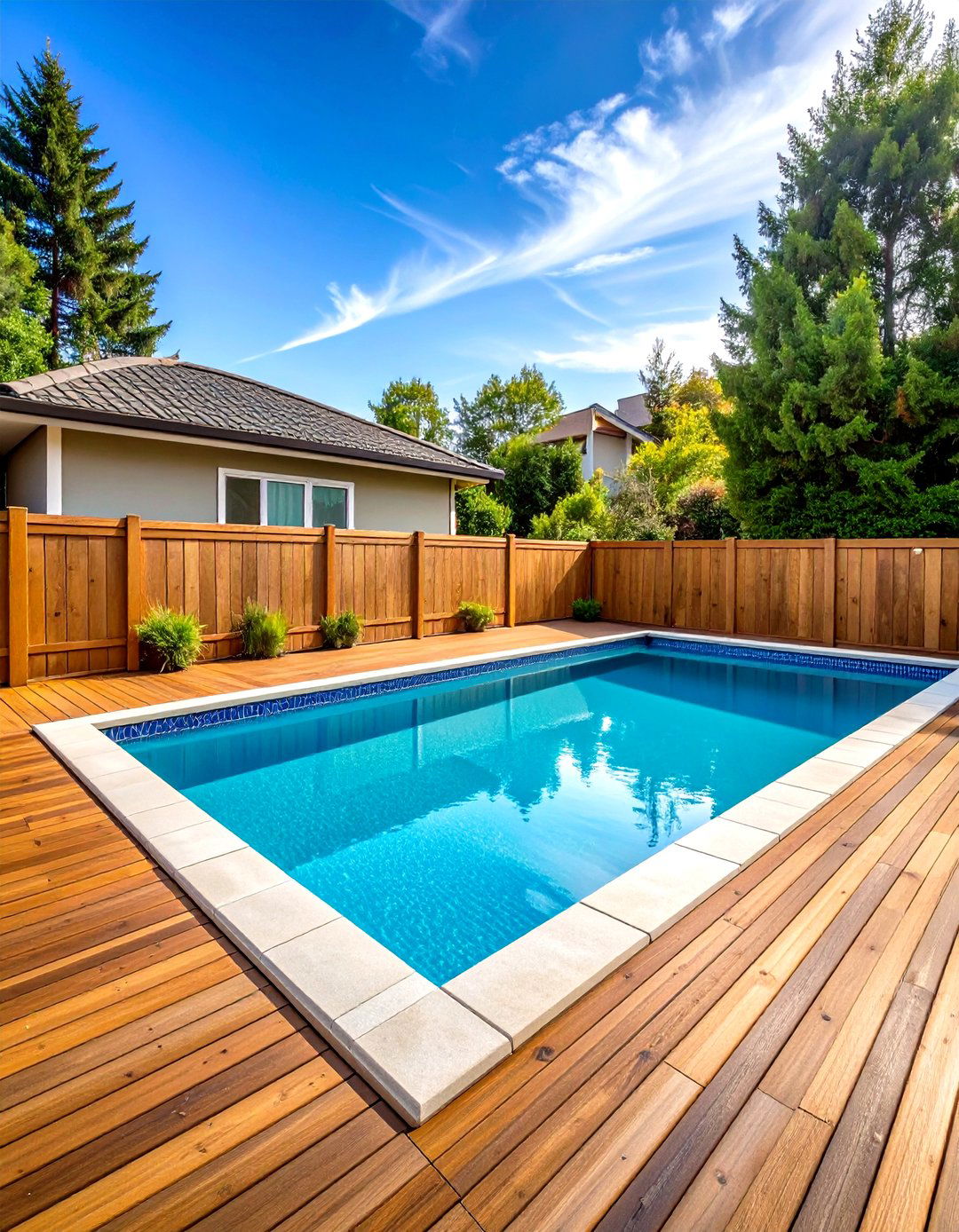
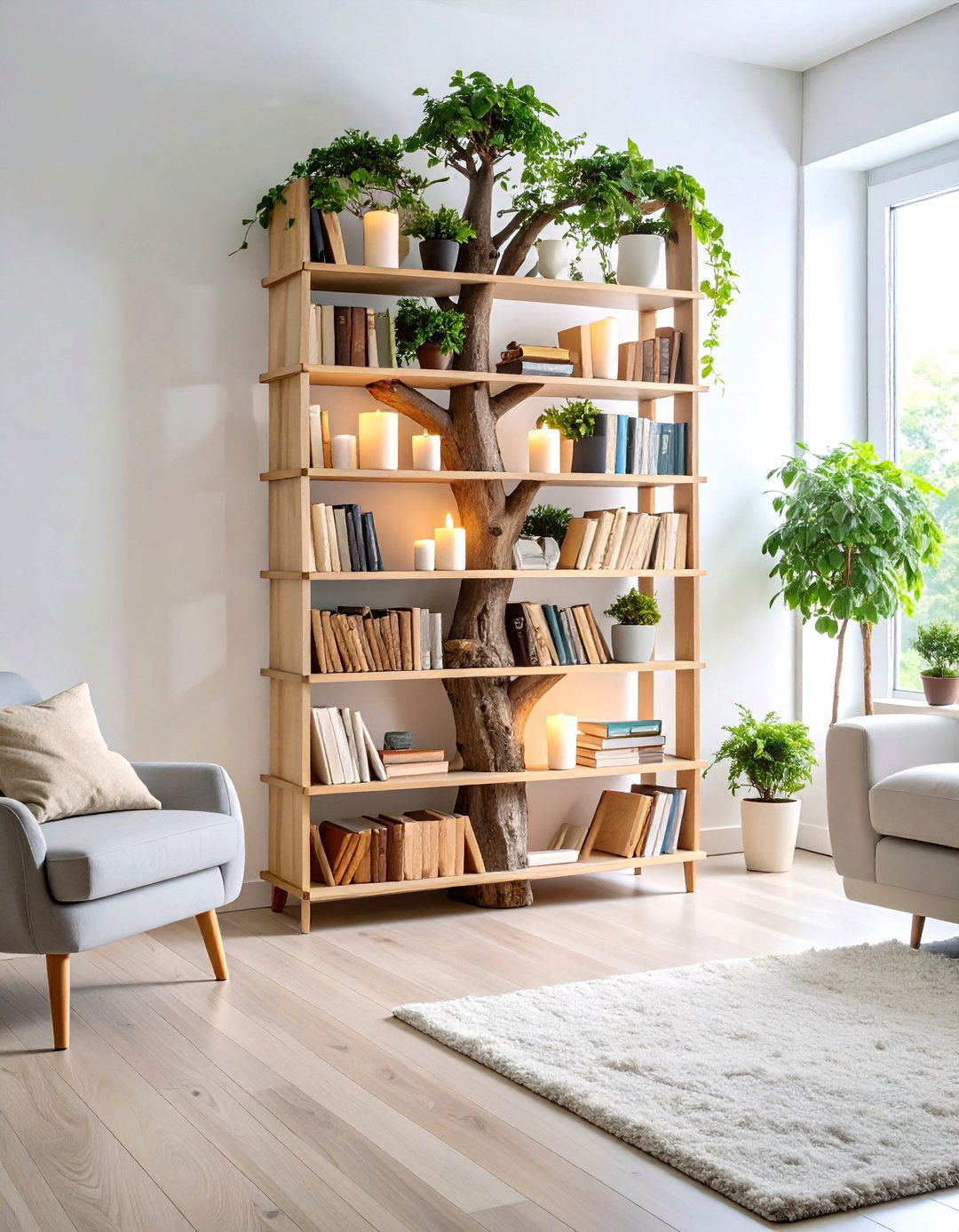

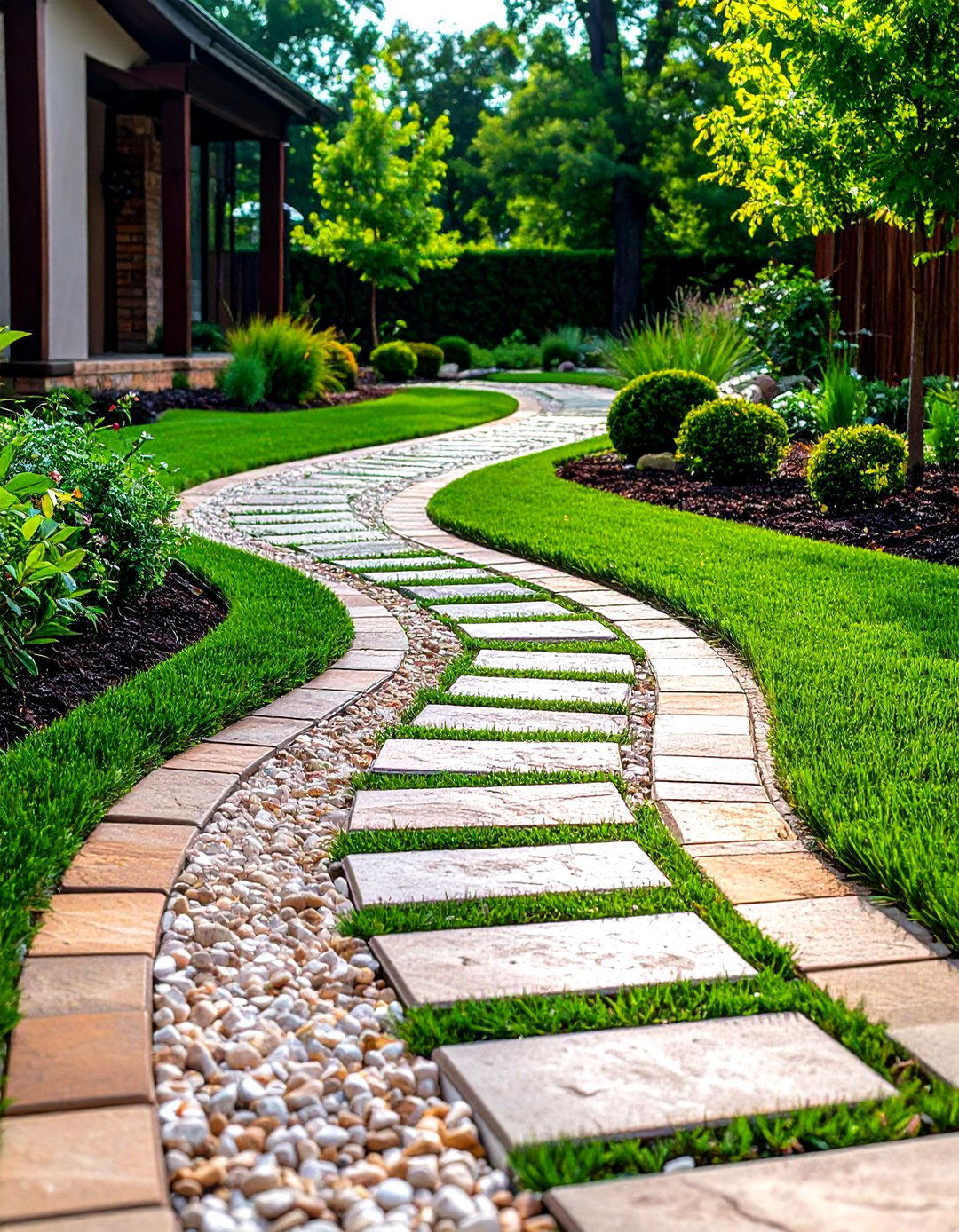
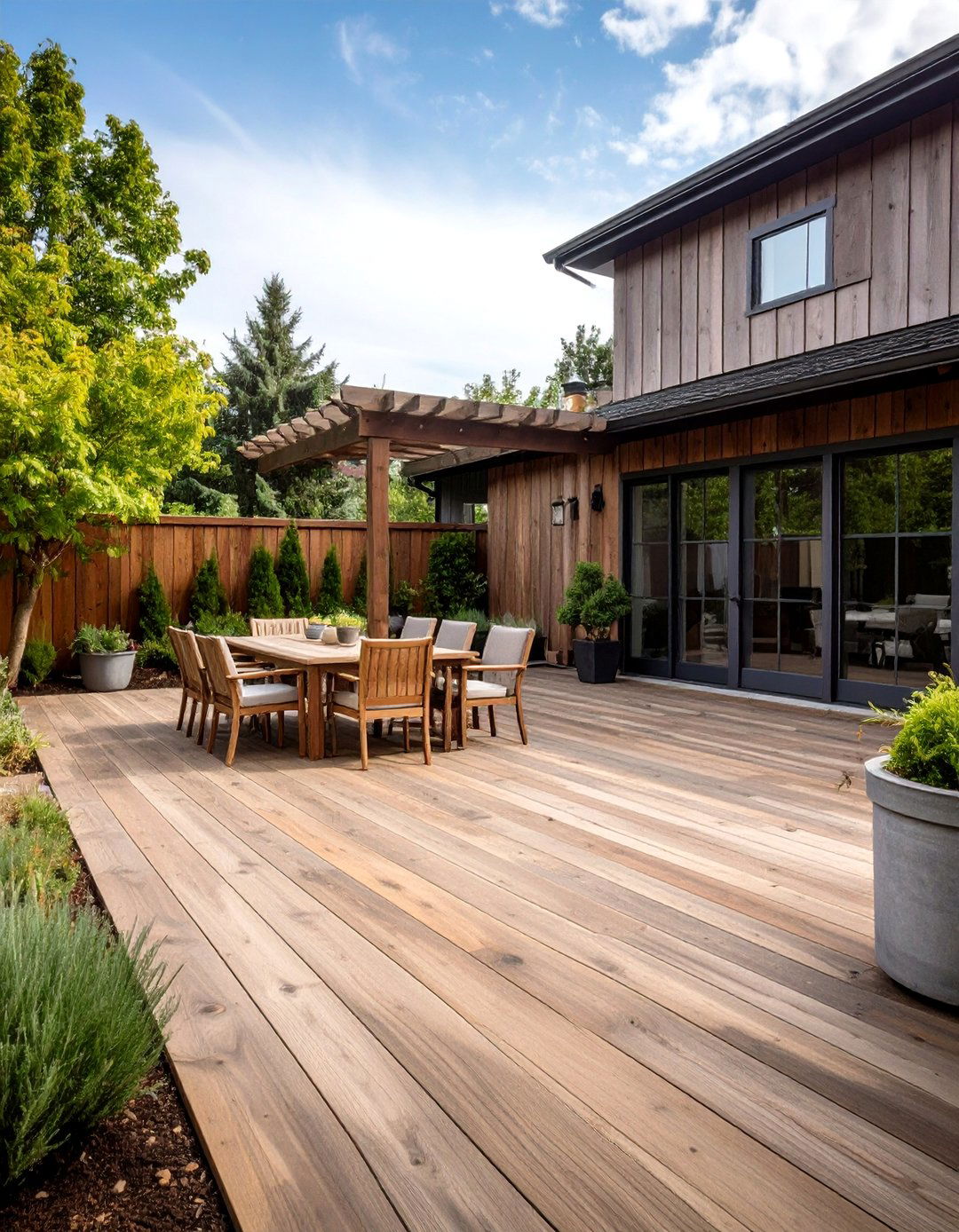
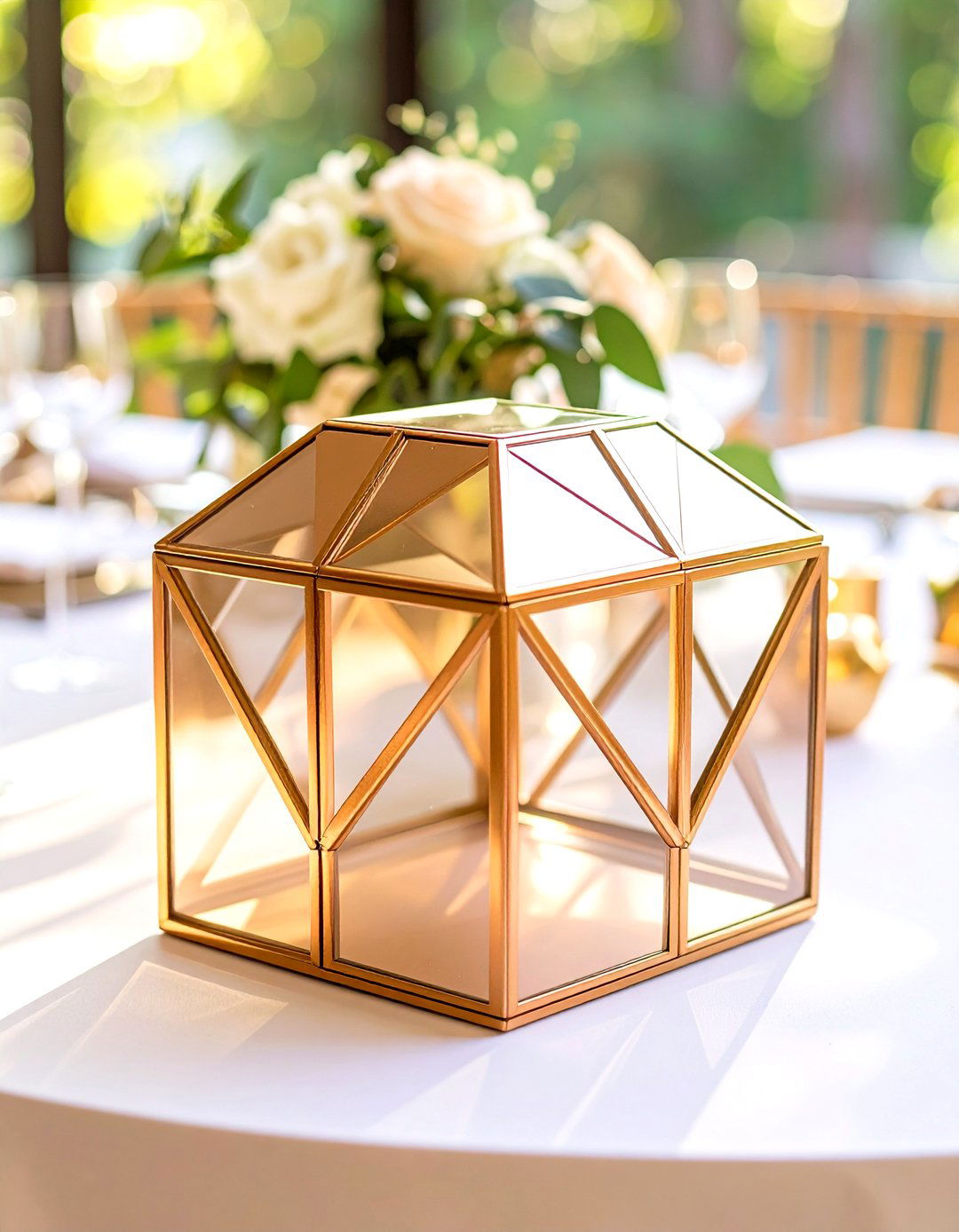
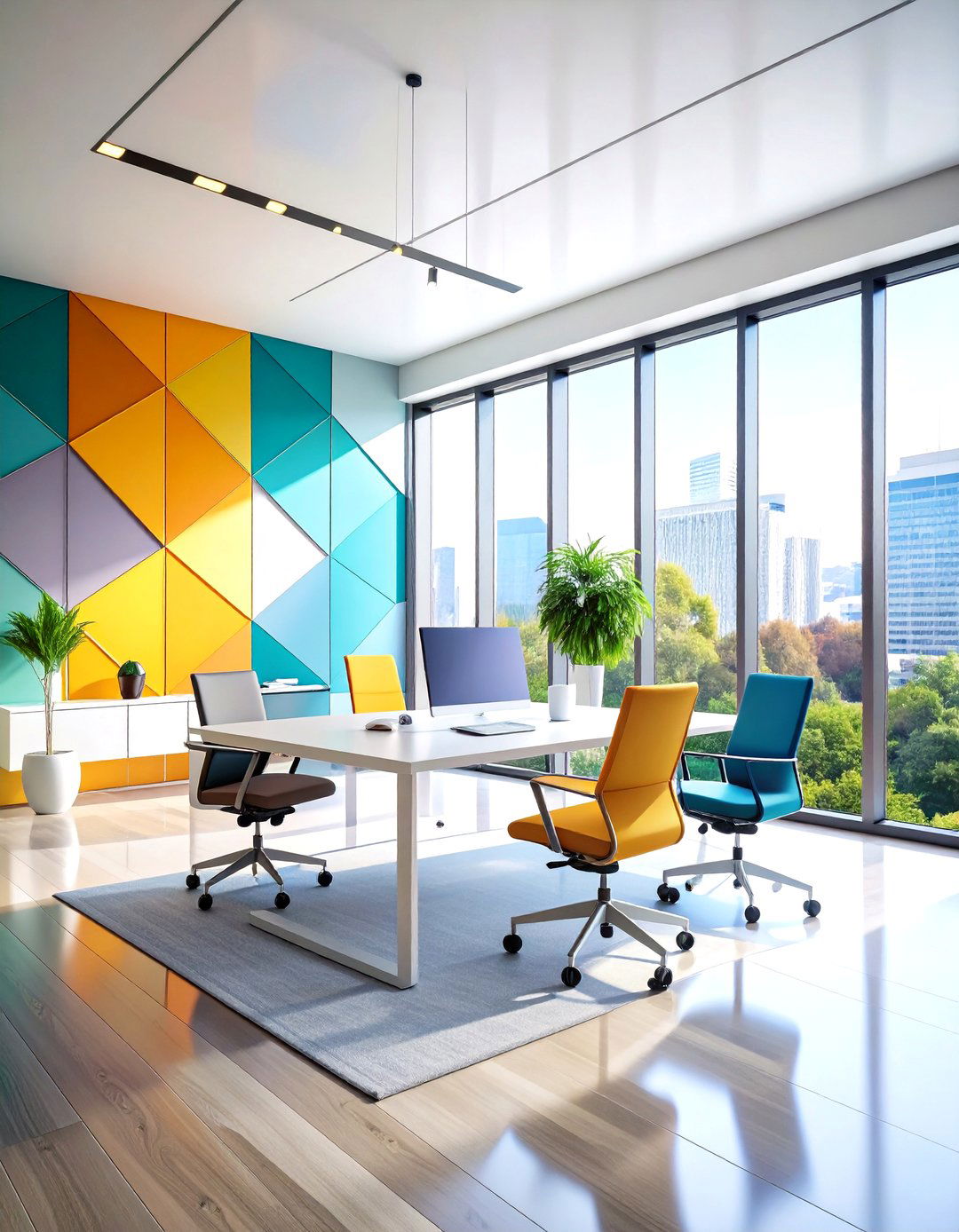



Leave a Reply